Efficient Resource Management in IaaS Cloud
VerifiedAdded on 2023/01/18
|24
|9959
|44
AI Summary
This research study focuses on efficient resource management in Infrastructure as a Service (IaaS) cloud. It discusses the concept of resource management, different processes, and techniques for managing resources in the cloud. The study also highlights the importance of resource management in providing uninterrupted services.
Contribute Materials
Your contribution can guide someone’s learning journey. Share your
documents today.
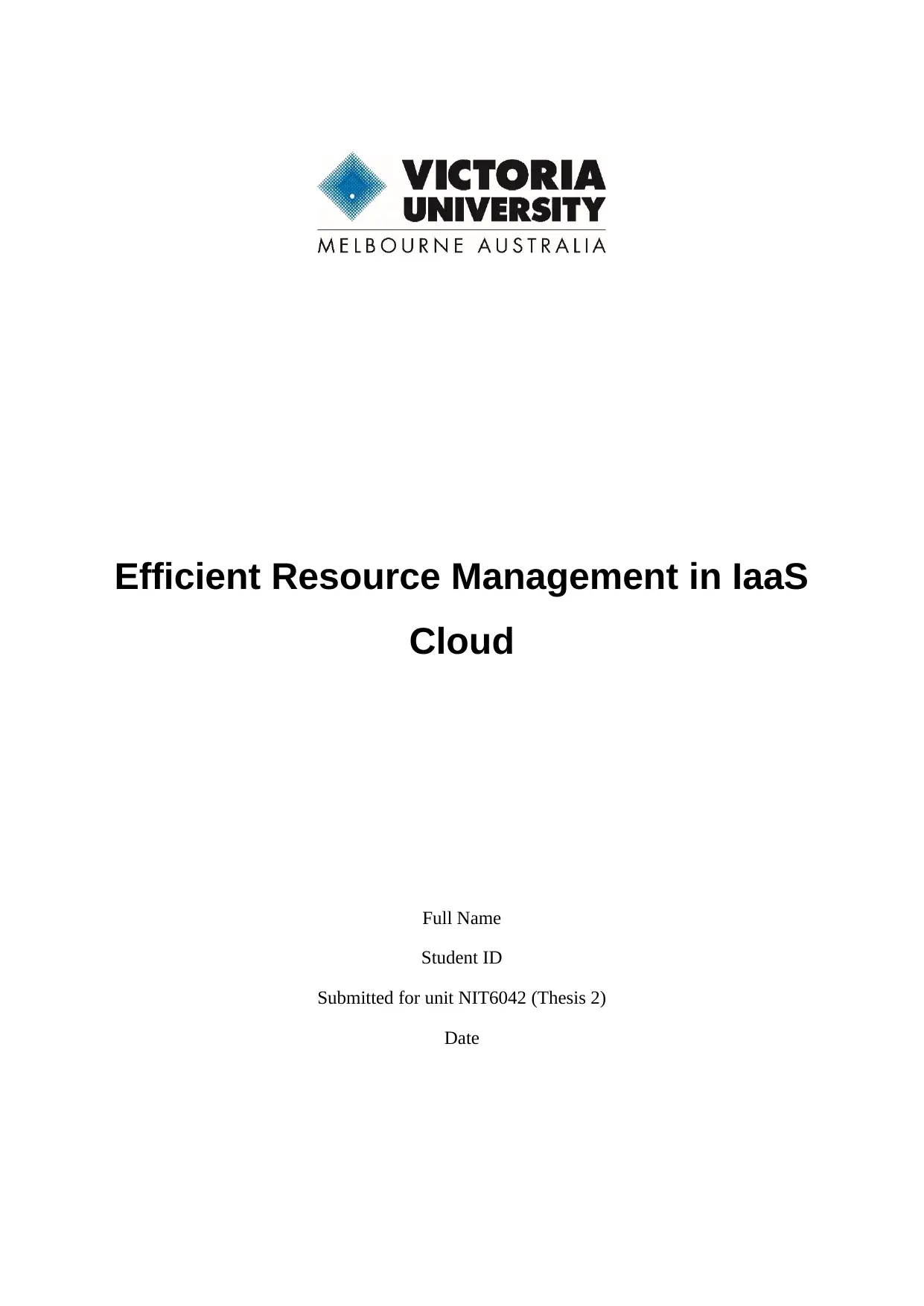
Efficient Resource Management in IaaS
Cloud
Full Name
Student ID
Submitted for unit NIT6042 (Thesis 2)
Date
Cloud
Full Name
Student ID
Submitted for unit NIT6042 (Thesis 2)
Date
Secure Best Marks with AI Grader
Need help grading? Try our AI Grader for instant feedback on your assignments.
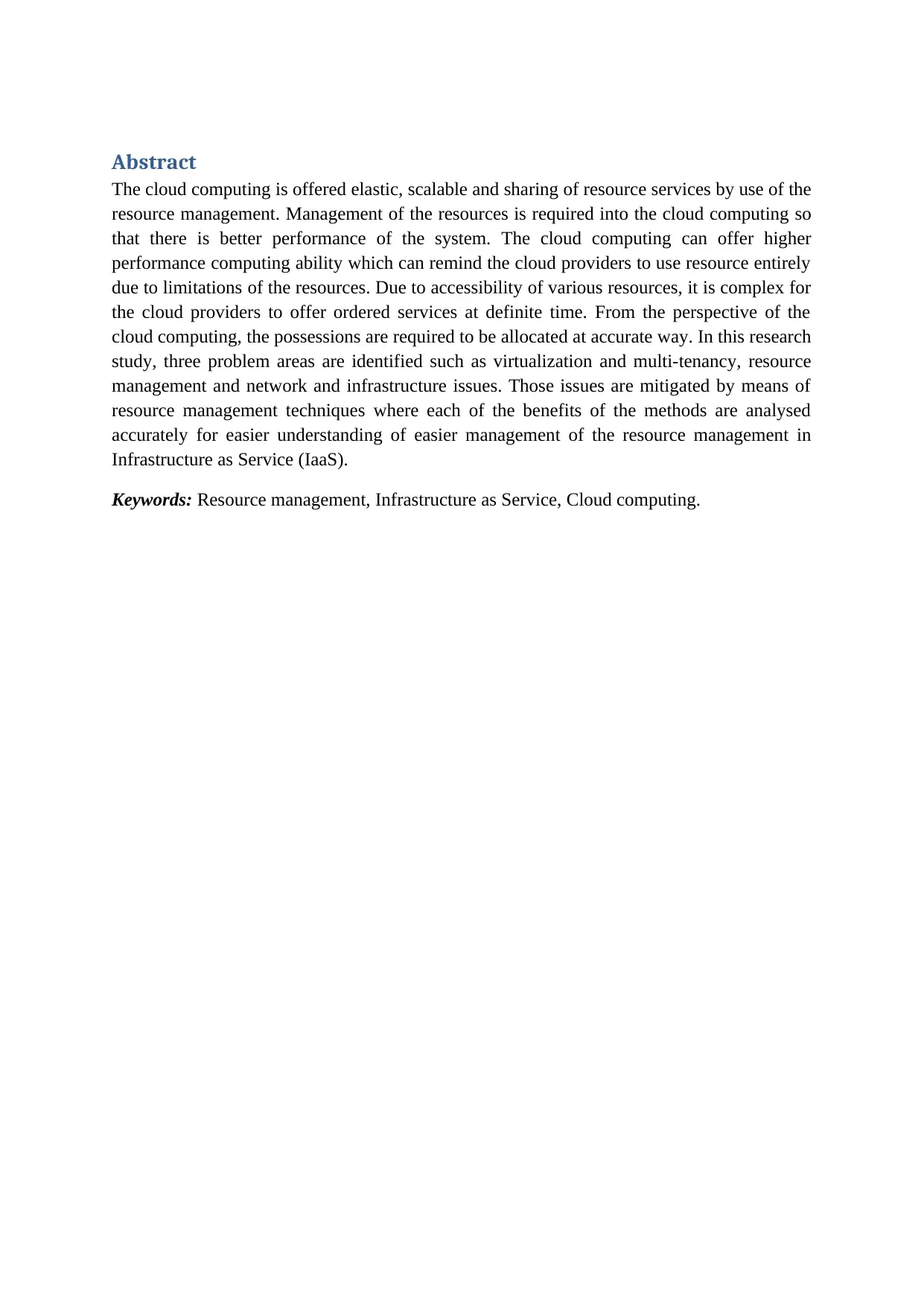
Abstract
The cloud computing is offered elastic, scalable and sharing of resource services by use of the
resource management. Management of the resources is required into the cloud computing so
that there is better performance of the system. The cloud computing can offer higher
performance computing ability which can remind the cloud providers to use resource entirely
due to limitations of the resources. Due to accessibility of various resources, it is complex for
the cloud providers to offer ordered services at definite time. From the perspective of the
cloud computing, the possessions are required to be allocated at accurate way. In this research
study, three problem areas are identified such as virtualization and multi-tenancy, resource
management and network and infrastructure issues. Those issues are mitigated by means of
resource management techniques where each of the benefits of the methods are analysed
accurately for easier understanding of easier management of the resource management in
Infrastructure as Service (IaaS).
Keywords: Resource management, Infrastructure as Service, Cloud computing.
The cloud computing is offered elastic, scalable and sharing of resource services by use of the
resource management. Management of the resources is required into the cloud computing so
that there is better performance of the system. The cloud computing can offer higher
performance computing ability which can remind the cloud providers to use resource entirely
due to limitations of the resources. Due to accessibility of various resources, it is complex for
the cloud providers to offer ordered services at definite time. From the perspective of the
cloud computing, the possessions are required to be allocated at accurate way. In this research
study, three problem areas are identified such as virtualization and multi-tenancy, resource
management and network and infrastructure issues. Those issues are mitigated by means of
resource management techniques where each of the benefits of the methods are analysed
accurately for easier understanding of easier management of the resource management in
Infrastructure as Service (IaaS).
Keywords: Resource management, Infrastructure as Service, Cloud computing.
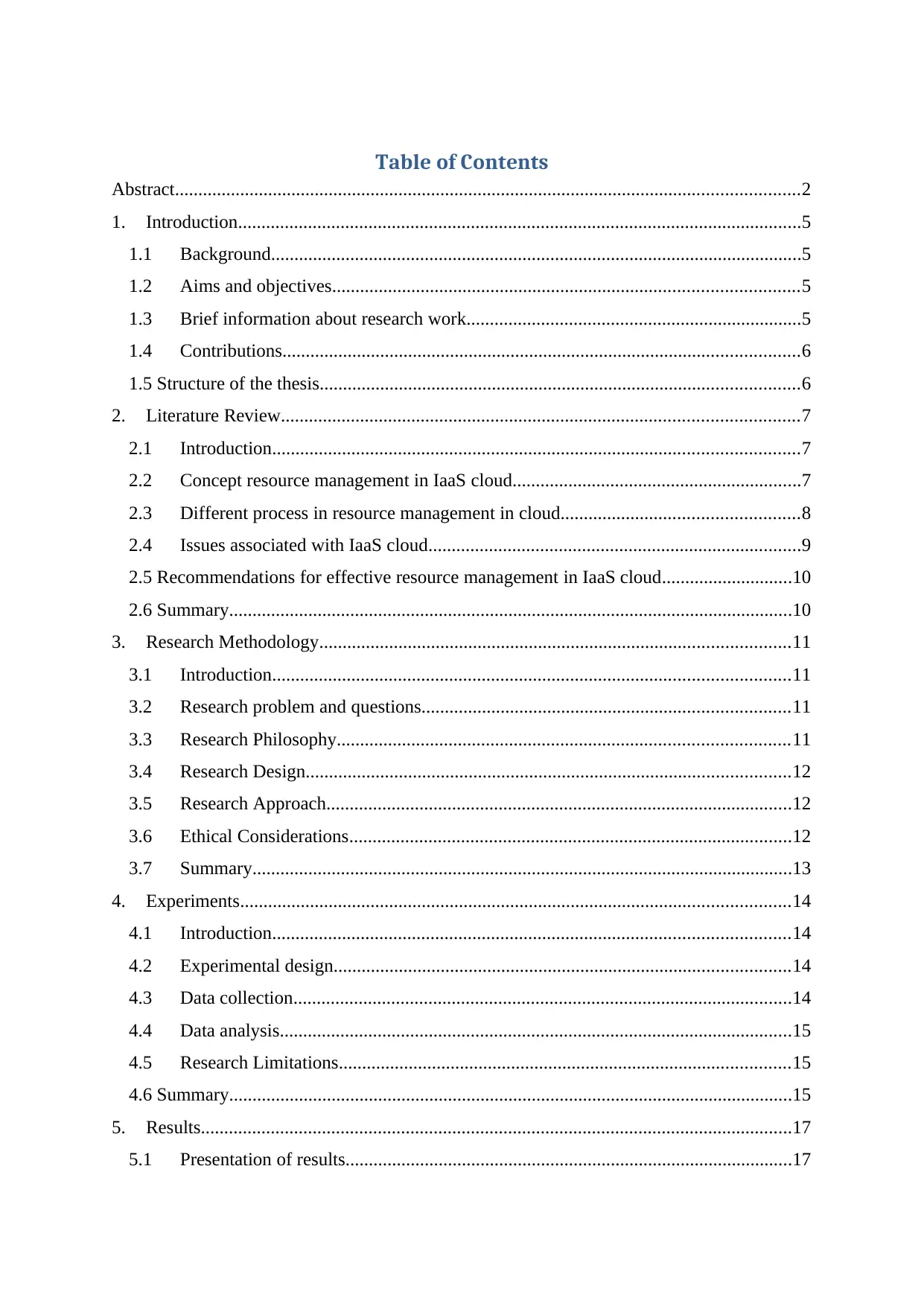
Table of Contents
Abstract......................................................................................................................................2
1. Introduction.........................................................................................................................5
1.1 Background..................................................................................................................5
1.2 Aims and objectives....................................................................................................5
1.3 Brief information about research work........................................................................5
1.4 Contributions...............................................................................................................6
1.5 Structure of the thesis.......................................................................................................6
2. Literature Review...............................................................................................................7
2.1 Introduction.................................................................................................................7
2.2 Concept resource management in IaaS cloud..............................................................7
2.3 Different process in resource management in cloud...................................................8
2.4 Issues associated with IaaS cloud................................................................................9
2.5 Recommendations for effective resource management in IaaS cloud............................10
2.6 Summary.........................................................................................................................10
3. Research Methodology.....................................................................................................11
3.1 Introduction...............................................................................................................11
3.2 Research problem and questions...............................................................................11
3.3 Research Philosophy.................................................................................................11
3.4 Research Design........................................................................................................12
3.5 Research Approach....................................................................................................12
3.6 Ethical Considerations...............................................................................................12
3.7 Summary....................................................................................................................13
4. Experiments......................................................................................................................14
4.1 Introduction...............................................................................................................14
4.2 Experimental design..................................................................................................14
4.3 Data collection...........................................................................................................14
4.4 Data analysis..............................................................................................................15
4.5 Research Limitations.................................................................................................15
4.6 Summary.........................................................................................................................15
5. Results...............................................................................................................................17
5.1 Presentation of results................................................................................................17
Abstract......................................................................................................................................2
1. Introduction.........................................................................................................................5
1.1 Background..................................................................................................................5
1.2 Aims and objectives....................................................................................................5
1.3 Brief information about research work........................................................................5
1.4 Contributions...............................................................................................................6
1.5 Structure of the thesis.......................................................................................................6
2. Literature Review...............................................................................................................7
2.1 Introduction.................................................................................................................7
2.2 Concept resource management in IaaS cloud..............................................................7
2.3 Different process in resource management in cloud...................................................8
2.4 Issues associated with IaaS cloud................................................................................9
2.5 Recommendations for effective resource management in IaaS cloud............................10
2.6 Summary.........................................................................................................................10
3. Research Methodology.....................................................................................................11
3.1 Introduction...............................................................................................................11
3.2 Research problem and questions...............................................................................11
3.3 Research Philosophy.................................................................................................11
3.4 Research Design........................................................................................................12
3.5 Research Approach....................................................................................................12
3.6 Ethical Considerations...............................................................................................12
3.7 Summary....................................................................................................................13
4. Experiments......................................................................................................................14
4.1 Introduction...............................................................................................................14
4.2 Experimental design..................................................................................................14
4.3 Data collection...........................................................................................................14
4.4 Data analysis..............................................................................................................15
4.5 Research Limitations.................................................................................................15
4.6 Summary.........................................................................................................................15
5. Results...............................................................................................................................17
5.1 Presentation of results................................................................................................17

5.2 Discussion..................................................................................................................19
6. Conclusion........................................................................................................................22
References................................................................................................................................23
6. Conclusion........................................................................................................................22
References................................................................................................................................23
Secure Best Marks with AI Grader
Need help grading? Try our AI Grader for instant feedback on your assignments.
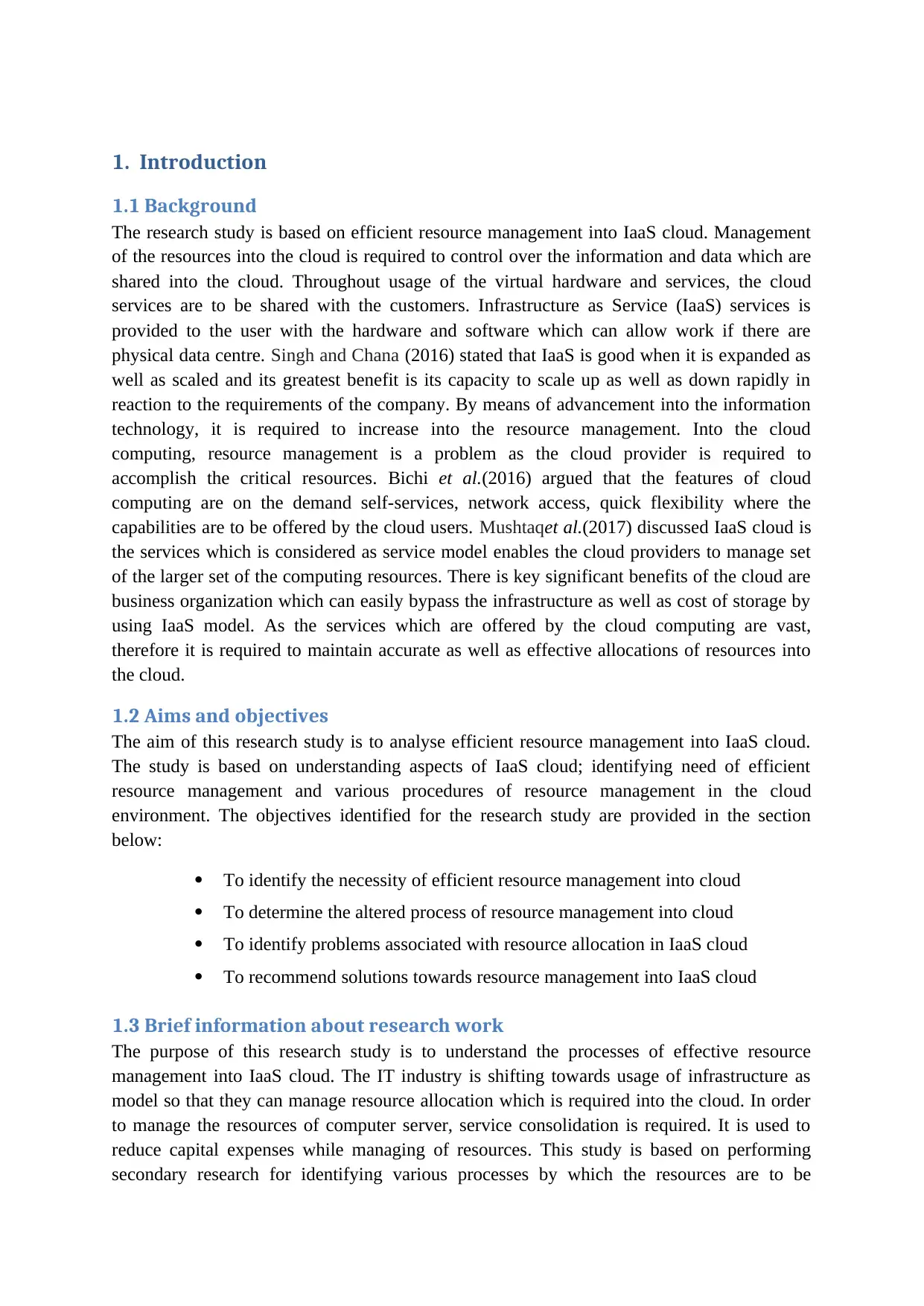
1. Introduction
1.1 Background
The research study is based on efficient resource management into IaaS cloud. Management
of the resources into the cloud is required to control over the information and data which are
shared into the cloud. Throughout usage of the virtual hardware and services, the cloud
services are to be shared with the customers. Infrastructure as Service (IaaS) services is
provided to the user with the hardware and software which can allow work if there are
physical data centre. Singh and Chana (2016) stated that IaaS is good when it is expanded as
well as scaled and its greatest benefit is its capacity to scale up as well as down rapidly in
reaction to the requirements of the company. By means of advancement into the information
technology, it is required to increase into the resource management. Into the cloud
computing, resource management is a problem as the cloud provider is required to
accomplish the critical resources. Bichi et al.(2016) argued that the features of cloud
computing are on the demand self-services, network access, quick flexibility where the
capabilities are to be offered by the cloud users. Mushtaqet al.(2017) discussed IaaS cloud is
the services which is considered as service model enables the cloud providers to manage set
of the larger set of the computing resources. There is key significant benefits of the cloud are
business organization which can easily bypass the infrastructure as well as cost of storage by
using IaaS model. As the services which are offered by the cloud computing are vast,
therefore it is required to maintain accurate as well as effective allocations of resources into
the cloud.
1.2 Aims and objectives
The aim of this research study is to analyse efficient resource management into IaaS cloud.
The study is based on understanding aspects of IaaS cloud; identifying need of efficient
resource management and various procedures of resource management in the cloud
environment. The objectives identified for the research study are provided in the section
below:
To identify the necessity of efficient resource management into cloud
To determine the altered process of resource management into cloud
To identify problems associated with resource allocation in IaaS cloud
To recommend solutions towards resource management into IaaS cloud
1.3 Brief information about research work
The purpose of this research study is to understand the processes of effective resource
management into IaaS cloud. The IT industry is shifting towards usage of infrastructure as
model so that they can manage resource allocation which is required into the cloud. In order
to manage the resources of computer server, service consolidation is required. It is used to
reduce capital expenses while managing of resources. This study is based on performing
secondary research for identifying various processes by which the resources are to be
1.1 Background
The research study is based on efficient resource management into IaaS cloud. Management
of the resources into the cloud is required to control over the information and data which are
shared into the cloud. Throughout usage of the virtual hardware and services, the cloud
services are to be shared with the customers. Infrastructure as Service (IaaS) services is
provided to the user with the hardware and software which can allow work if there are
physical data centre. Singh and Chana (2016) stated that IaaS is good when it is expanded as
well as scaled and its greatest benefit is its capacity to scale up as well as down rapidly in
reaction to the requirements of the company. By means of advancement into the information
technology, it is required to increase into the resource management. Into the cloud
computing, resource management is a problem as the cloud provider is required to
accomplish the critical resources. Bichi et al.(2016) argued that the features of cloud
computing are on the demand self-services, network access, quick flexibility where the
capabilities are to be offered by the cloud users. Mushtaqet al.(2017) discussed IaaS cloud is
the services which is considered as service model enables the cloud providers to manage set
of the larger set of the computing resources. There is key significant benefits of the cloud are
business organization which can easily bypass the infrastructure as well as cost of storage by
using IaaS model. As the services which are offered by the cloud computing are vast,
therefore it is required to maintain accurate as well as effective allocations of resources into
the cloud.
1.2 Aims and objectives
The aim of this research study is to analyse efficient resource management into IaaS cloud.
The study is based on understanding aspects of IaaS cloud; identifying need of efficient
resource management and various procedures of resource management in the cloud
environment. The objectives identified for the research study are provided in the section
below:
To identify the necessity of efficient resource management into cloud
To determine the altered process of resource management into cloud
To identify problems associated with resource allocation in IaaS cloud
To recommend solutions towards resource management into IaaS cloud
1.3 Brief information about research work
The purpose of this research study is to understand the processes of effective resource
management into IaaS cloud. The IT industry is shifting towards usage of infrastructure as
model so that they can manage resource allocation which is required into the cloud. In order
to manage the resources of computer server, service consolidation is required. It is used to
reduce capital expenses while managing of resources. This study is based on performing
secondary research for identifying various processes by which the resources are to be

managed into the IaaS cloud. The research study is based on identifying issues which are
associated with resource allocation and recommended solutions to manage those problems
along with using IaaS model.
1.4 Contributions
The research study is contributed towards the identified research objectives based on which
the study is to be accepted out. The research questions which are related to the research study
are:
1. What are issues which are associated with resource allocation in IaaS cloud?
2. Why is it required to manage the resources into IaaS cloud?
3. What are the recommendations for effective management of resources in IaaS cloud?
Research methods are chosen to conduct this particular study. The peer review articles based
on selected topic are selected to respond to above identified research questions. Those are
undertaken along with research objectives and aim of research. Process of the resource
allocation provides significant influence on the cloud computing. In this purpose, tenant
based allocation model is to be required which will improve and validate the infrastructure.
The resources are required to manage in such a way that specific cloud applications are
needed.
1.5 Structure of the thesis
The thesis paper 2 is divided into six sections such that the selected topic is being highlighted
in each sections in detailed way.
Introduction: The basic details related to selected thesis topic are described such as
background, aim, objectives, and research questions for providing information on effective
resource management in IaaS cloud.
Literature review: The researcher helps to understand selected topic by help of literature
sources. The investigator is tried to provide theory of the study in standard way.
Research methodology: This section is helpful to gain understanding of the research methods
and processes guide path that lead to improved study the theme and gather data associated to
the study. There is assortment of methods followed by application of accurate justification on
chosen research methods.
Experiments: This section provides details of the selected data collection methods and data
analysis technique which help to gather data from the peer review sources.
Results: Based on the data collection and data analysis, the investigator is opted for the data
study of the sources such that appropriate research results are to be generated.
Conclusion: It presents overall sight of the research study which will help to comprise results
of selected thesis topic, based on the research objectives the researcher will settle on the
findings.
associated with resource allocation and recommended solutions to manage those problems
along with using IaaS model.
1.4 Contributions
The research study is contributed towards the identified research objectives based on which
the study is to be accepted out. The research questions which are related to the research study
are:
1. What are issues which are associated with resource allocation in IaaS cloud?
2. Why is it required to manage the resources into IaaS cloud?
3. What are the recommendations for effective management of resources in IaaS cloud?
Research methods are chosen to conduct this particular study. The peer review articles based
on selected topic are selected to respond to above identified research questions. Those are
undertaken along with research objectives and aim of research. Process of the resource
allocation provides significant influence on the cloud computing. In this purpose, tenant
based allocation model is to be required which will improve and validate the infrastructure.
The resources are required to manage in such a way that specific cloud applications are
needed.
1.5 Structure of the thesis
The thesis paper 2 is divided into six sections such that the selected topic is being highlighted
in each sections in detailed way.
Introduction: The basic details related to selected thesis topic are described such as
background, aim, objectives, and research questions for providing information on effective
resource management in IaaS cloud.
Literature review: The researcher helps to understand selected topic by help of literature
sources. The investigator is tried to provide theory of the study in standard way.
Research methodology: This section is helpful to gain understanding of the research methods
and processes guide path that lead to improved study the theme and gather data associated to
the study. There is assortment of methods followed by application of accurate justification on
chosen research methods.
Experiments: This section provides details of the selected data collection methods and data
analysis technique which help to gather data from the peer review sources.
Results: Based on the data collection and data analysis, the investigator is opted for the data
study of the sources such that appropriate research results are to be generated.
Conclusion: It presents overall sight of the research study which will help to comprise results
of selected thesis topic, based on the research objectives the researcher will settle on the
findings.
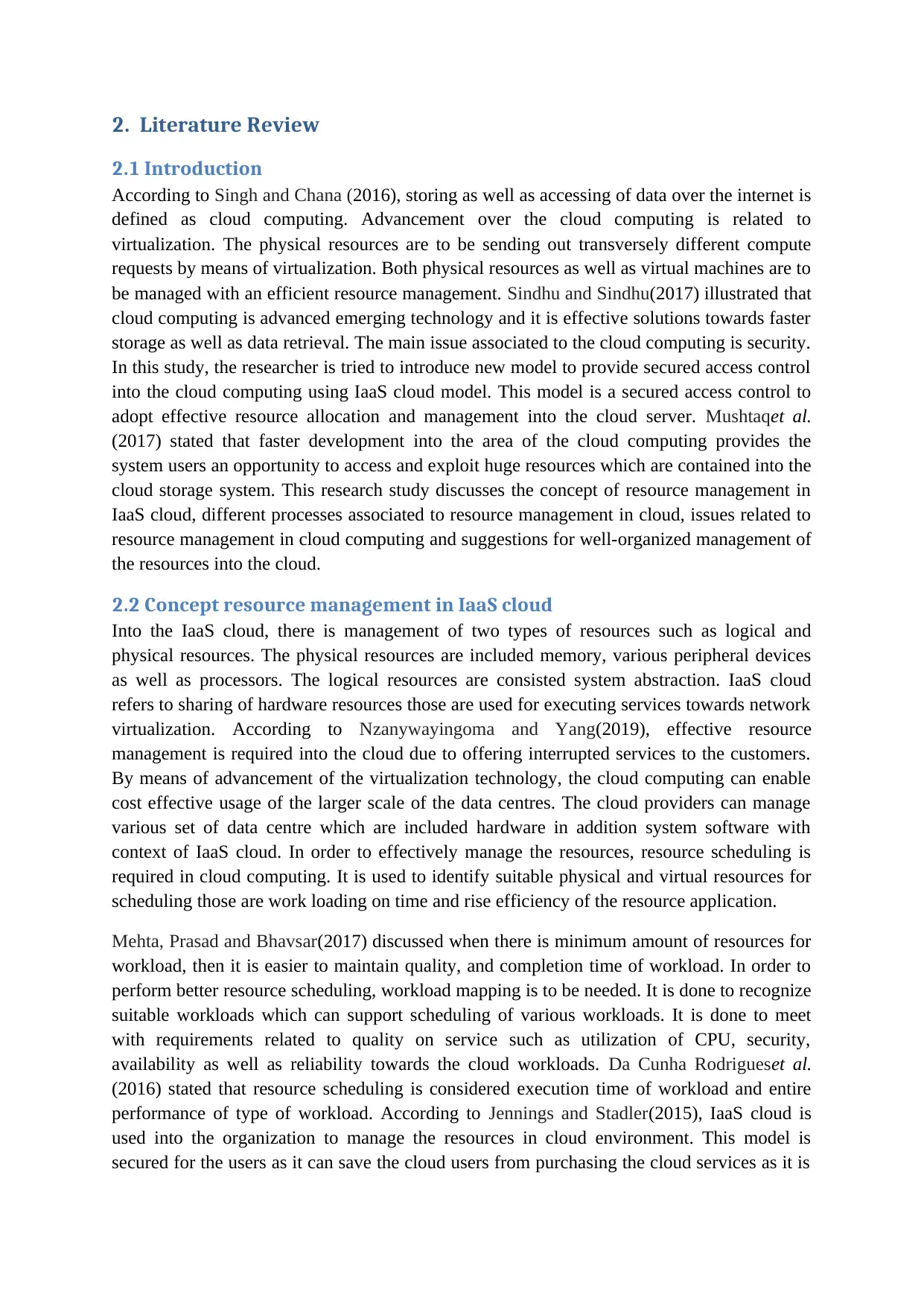
2. Literature Review
2.1 Introduction
According to Singh and Chana (2016), storing as well as accessing of data over the internet is
defined as cloud computing. Advancement over the cloud computing is related to
virtualization. The physical resources are to be sending out transversely different compute
requests by means of virtualization. Both physical resources as well as virtual machines are to
be managed with an efficient resource management. Sindhu and Sindhu(2017) illustrated that
cloud computing is advanced emerging technology and it is effective solutions towards faster
storage as well as data retrieval. The main issue associated to the cloud computing is security.
In this study, the researcher is tried to introduce new model to provide secured access control
into the cloud computing using IaaS cloud model. This model is a secured access control to
adopt effective resource allocation and management into the cloud server. Mushtaqet al.
(2017) stated that faster development into the area of the cloud computing provides the
system users an opportunity to access and exploit huge resources which are contained into the
cloud storage system. This research study discusses the concept of resource management in
IaaS cloud, different processes associated to resource management in cloud, issues related to
resource management in cloud computing and suggestions for well-organized management of
the resources into the cloud.
2.2 Concept resource management in IaaS cloud
Into the IaaS cloud, there is management of two types of resources such as logical and
physical resources. The physical resources are included memory, various peripheral devices
as well as processors. The logical resources are consisted system abstraction. IaaS cloud
refers to sharing of hardware resources those are used for executing services towards network
virtualization. According to Nzanywayingoma and Yang(2019), effective resource
management is required into the cloud due to offering interrupted services to the customers.
By means of advancement of the virtualization technology, the cloud computing can enable
cost effective usage of the larger scale of the data centres. The cloud providers can manage
various set of data centre which are included hardware in addition system software with
context of IaaS cloud. In order to effectively manage the resources, resource scheduling is
required in cloud computing. It is used to identify suitable physical and virtual resources for
scheduling those are work loading on time and rise efficiency of the resource application.
Mehta, Prasad and Bhavsar(2017) discussed when there is minimum amount of resources for
workload, then it is easier to maintain quality, and completion time of workload. In order to
perform better resource scheduling, workload mapping is to be needed. It is done to recognize
suitable workloads which can support scheduling of various workloads. It is done to meet
with requirements related to quality on service such as utilization of CPU, security,
availability as well as reliability towards the cloud workloads. Da Cunha Rodrigueset al.
(2016) stated that resource scheduling is considered execution time of workload and entire
performance of type of workload. According to Jennings and Stadler(2015), IaaS cloud is
used into the organization to manage the resources in cloud environment. This model is
secured for the users as it can save the cloud users from purchasing the cloud services as it is
2.1 Introduction
According to Singh and Chana (2016), storing as well as accessing of data over the internet is
defined as cloud computing. Advancement over the cloud computing is related to
virtualization. The physical resources are to be sending out transversely different compute
requests by means of virtualization. Both physical resources as well as virtual machines are to
be managed with an efficient resource management. Sindhu and Sindhu(2017) illustrated that
cloud computing is advanced emerging technology and it is effective solutions towards faster
storage as well as data retrieval. The main issue associated to the cloud computing is security.
In this study, the researcher is tried to introduce new model to provide secured access control
into the cloud computing using IaaS cloud model. This model is a secured access control to
adopt effective resource allocation and management into the cloud server. Mushtaqet al.
(2017) stated that faster development into the area of the cloud computing provides the
system users an opportunity to access and exploit huge resources which are contained into the
cloud storage system. This research study discusses the concept of resource management in
IaaS cloud, different processes associated to resource management in cloud, issues related to
resource management in cloud computing and suggestions for well-organized management of
the resources into the cloud.
2.2 Concept resource management in IaaS cloud
Into the IaaS cloud, there is management of two types of resources such as logical and
physical resources. The physical resources are included memory, various peripheral devices
as well as processors. The logical resources are consisted system abstraction. IaaS cloud
refers to sharing of hardware resources those are used for executing services towards network
virtualization. According to Nzanywayingoma and Yang(2019), effective resource
management is required into the cloud due to offering interrupted services to the customers.
By means of advancement of the virtualization technology, the cloud computing can enable
cost effective usage of the larger scale of the data centres. The cloud providers can manage
various set of data centre which are included hardware in addition system software with
context of IaaS cloud. In order to effectively manage the resources, resource scheduling is
required in cloud computing. It is used to identify suitable physical and virtual resources for
scheduling those are work loading on time and rise efficiency of the resource application.
Mehta, Prasad and Bhavsar(2017) discussed when there is minimum amount of resources for
workload, then it is easier to maintain quality, and completion time of workload. In order to
perform better resource scheduling, workload mapping is to be needed. It is done to recognize
suitable workloads which can support scheduling of various workloads. It is done to meet
with requirements related to quality on service such as utilization of CPU, security,
availability as well as reliability towards the cloud workloads. Da Cunha Rodrigueset al.
(2016) stated that resource scheduling is considered execution time of workload and entire
performance of type of workload. According to Jennings and Stadler(2015), IaaS cloud is
used into the organization to manage the resources in cloud environment. This model is
secured for the users as it can save the cloud users from purchasing the cloud services as it is
Paraphrase This Document
Need a fresh take? Get an instant paraphrase of this document with our AI Paraphraser
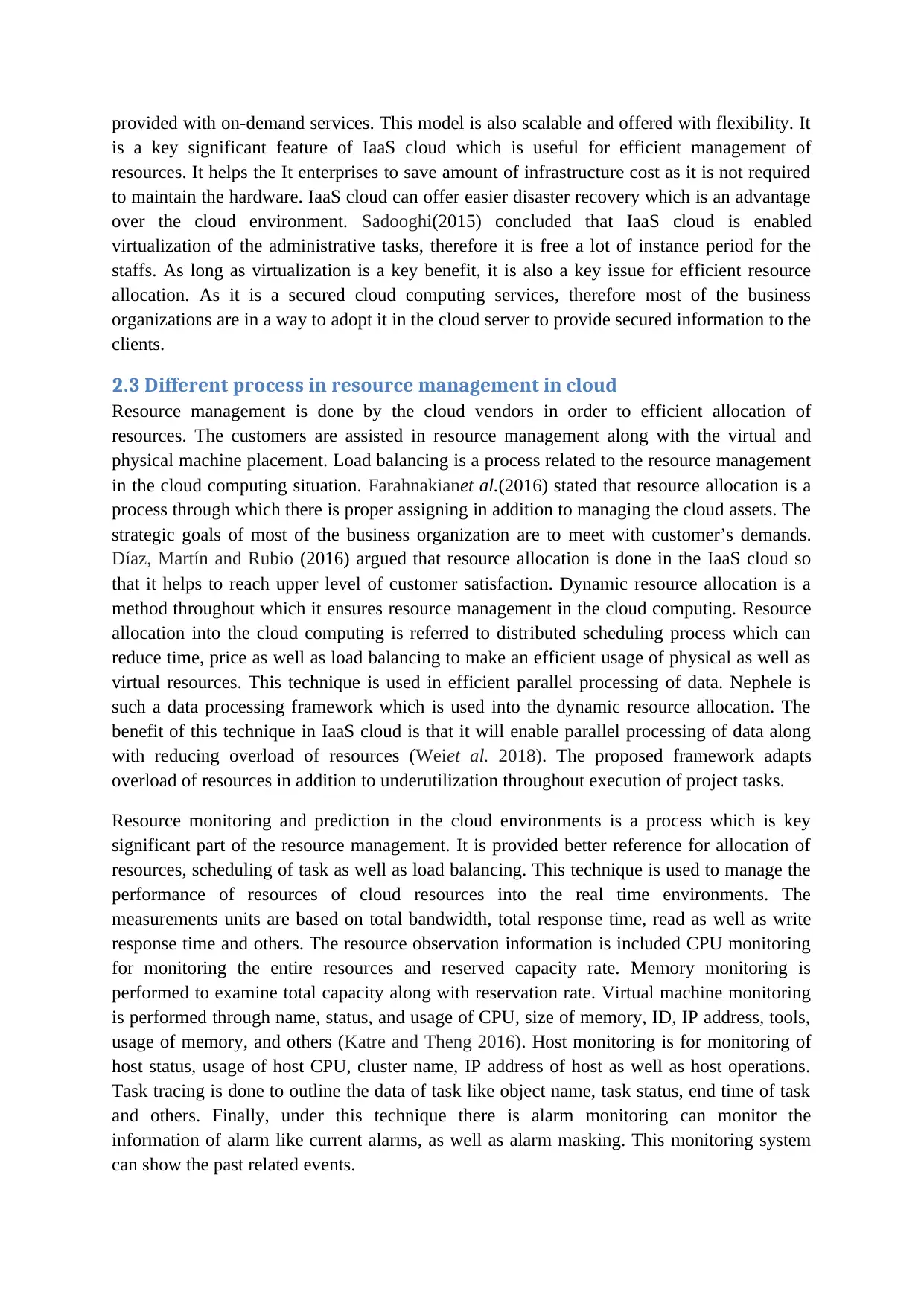
provided with on-demand services. This model is also scalable and offered with flexibility. It
is a key significant feature of IaaS cloud which is useful for efficient management of
resources. It helps the It enterprises to save amount of infrastructure cost as it is not required
to maintain the hardware. IaaS cloud can offer easier disaster recovery which is an advantage
over the cloud environment. Sadooghi(2015) concluded that IaaS cloud is enabled
virtualization of the administrative tasks, therefore it is free a lot of instance period for the
staffs. As long as virtualization is a key benefit, it is also a key issue for efficient resource
allocation. As it is a secured cloud computing services, therefore most of the business
organizations are in a way to adopt it in the cloud server to provide secured information to the
clients.
2.3 Different process in resource management in cloud
Resource management is done by the cloud vendors in order to efficient allocation of
resources. The customers are assisted in resource management along with the virtual and
physical machine placement. Load balancing is a process related to the resource management
in the cloud computing situation. Farahnakianet al.(2016) stated that resource allocation is a
process through which there is proper assigning in addition to managing the cloud assets. The
strategic goals of most of the business organization are to meet with customer’s demands.
Díaz, Martín and Rubio (2016) argued that resource allocation is done in the IaaS cloud so
that it helps to reach upper level of customer satisfaction. Dynamic resource allocation is a
method throughout which it ensures resource management in the cloud computing. Resource
allocation into the cloud computing is referred to distributed scheduling process which can
reduce time, price as well as load balancing to make an efficient usage of physical as well as
virtual resources. This technique is used in efficient parallel processing of data. Nephele is
such a data processing framework which is used into the dynamic resource allocation. The
benefit of this technique in IaaS cloud is that it will enable parallel processing of data along
with reducing overload of resources (Weiet al. 2018). The proposed framework adapts
overload of resources in addition to underutilization throughout execution of project tasks.
Resource monitoring and prediction in the cloud environments is a process which is key
significant part of the resource management. It is provided better reference for allocation of
resources, scheduling of task as well as load balancing. This technique is used to manage the
performance of resources of cloud resources into the real time environments. The
measurements units are based on total bandwidth, total response time, read as well as write
response time and others. The resource observation information is included CPU monitoring
for monitoring the entire resources and reserved capacity rate. Memory monitoring is
performed to examine total capacity along with reservation rate. Virtual machine monitoring
is performed through name, status, and usage of CPU, size of memory, ID, IP address, tools,
usage of memory, and others (Katre and Theng 2016). Host monitoring is for monitoring of
host status, usage of host CPU, cluster name, IP address of host as well as host operations.
Task tracing is done to outline the data of task like object name, task status, end time of task
and others. Finally, under this technique there is alarm monitoring can monitor the
information of alarm like current alarms, as well as alarm masking. This monitoring system
can show the past related events.
is a key significant feature of IaaS cloud which is useful for efficient management of
resources. It helps the It enterprises to save amount of infrastructure cost as it is not required
to maintain the hardware. IaaS cloud can offer easier disaster recovery which is an advantage
over the cloud environment. Sadooghi(2015) concluded that IaaS cloud is enabled
virtualization of the administrative tasks, therefore it is free a lot of instance period for the
staffs. As long as virtualization is a key benefit, it is also a key issue for efficient resource
allocation. As it is a secured cloud computing services, therefore most of the business
organizations are in a way to adopt it in the cloud server to provide secured information to the
clients.
2.3 Different process in resource management in cloud
Resource management is done by the cloud vendors in order to efficient allocation of
resources. The customers are assisted in resource management along with the virtual and
physical machine placement. Load balancing is a process related to the resource management
in the cloud computing situation. Farahnakianet al.(2016) stated that resource allocation is a
process through which there is proper assigning in addition to managing the cloud assets. The
strategic goals of most of the business organization are to meet with customer’s demands.
Díaz, Martín and Rubio (2016) argued that resource allocation is done in the IaaS cloud so
that it helps to reach upper level of customer satisfaction. Dynamic resource allocation is a
method throughout which it ensures resource management in the cloud computing. Resource
allocation into the cloud computing is referred to distributed scheduling process which can
reduce time, price as well as load balancing to make an efficient usage of physical as well as
virtual resources. This technique is used in efficient parallel processing of data. Nephele is
such a data processing framework which is used into the dynamic resource allocation. The
benefit of this technique in IaaS cloud is that it will enable parallel processing of data along
with reducing overload of resources (Weiet al. 2018). The proposed framework adapts
overload of resources in addition to underutilization throughout execution of project tasks.
Resource monitoring and prediction in the cloud environments is a process which is key
significant part of the resource management. It is provided better reference for allocation of
resources, scheduling of task as well as load balancing. This technique is used to manage the
performance of resources of cloud resources into the real time environments. The
measurements units are based on total bandwidth, total response time, read as well as write
response time and others. The resource observation information is included CPU monitoring
for monitoring the entire resources and reserved capacity rate. Memory monitoring is
performed to examine total capacity along with reservation rate. Virtual machine monitoring
is performed through name, status, and usage of CPU, size of memory, ID, IP address, tools,
usage of memory, and others (Katre and Theng 2016). Host monitoring is for monitoring of
host status, usage of host CPU, cluster name, IP address of host as well as host operations.
Task tracing is done to outline the data of task like object name, task status, end time of task
and others. Finally, under this technique there is alarm monitoring can monitor the
information of alarm like current alarms, as well as alarm masking. This monitoring system
can show the past related events.
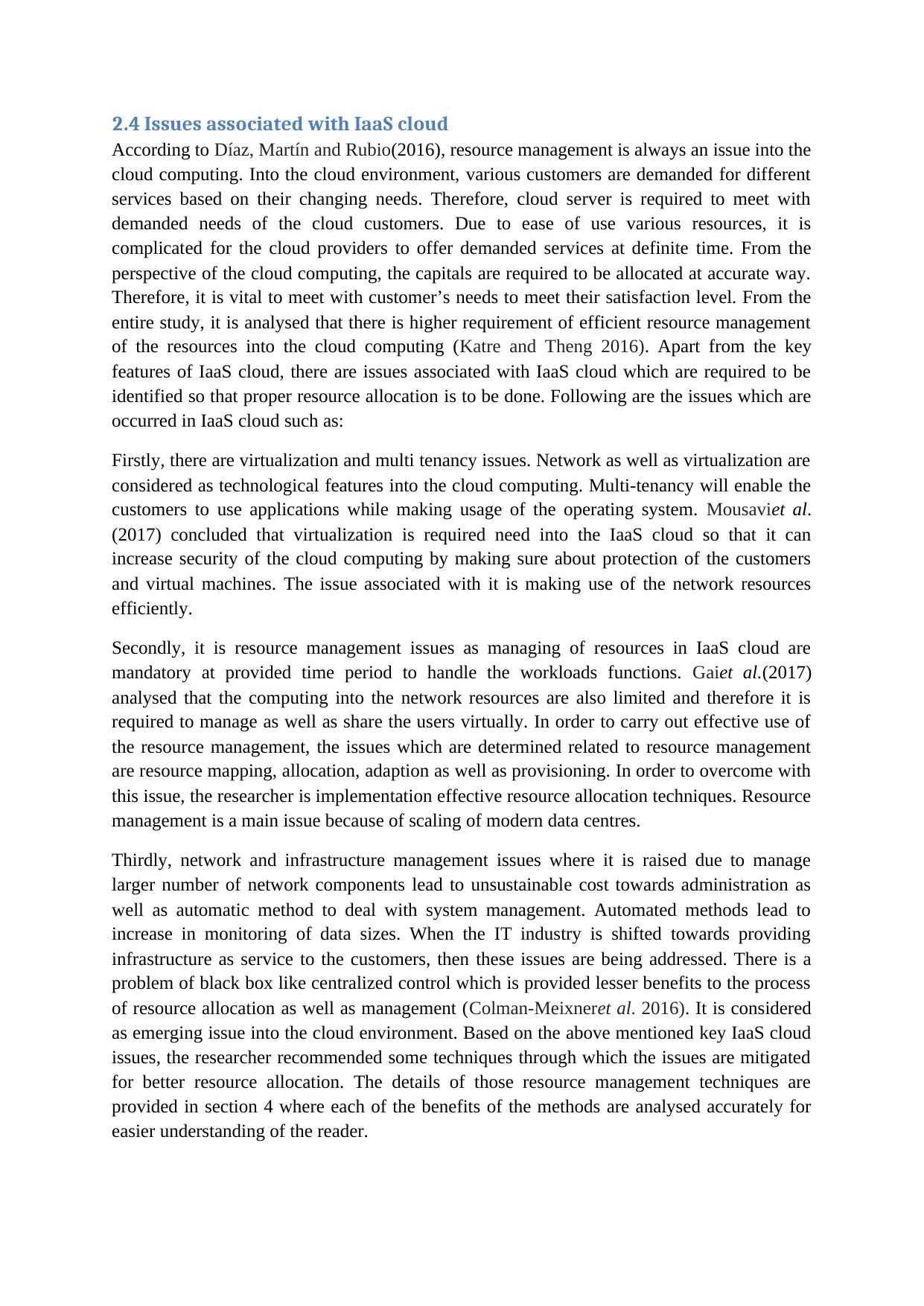
2.4 Issues associated with IaaS cloud
According to Díaz, Martín and Rubio(2016), resource management is always an issue into the
cloud computing. Into the cloud environment, various customers are demanded for different
services based on their changing needs. Therefore, cloud server is required to meet with
demanded needs of the cloud customers. Due to ease of use various resources, it is
complicated for the cloud providers to offer demanded services at definite time. From the
perspective of the cloud computing, the capitals are required to be allocated at accurate way.
Therefore, it is vital to meet with customer’s needs to meet their satisfaction level. From the
entire study, it is analysed that there is higher requirement of efficient resource management
of the resources into the cloud computing (Katre and Theng 2016). Apart from the key
features of IaaS cloud, there are issues associated with IaaS cloud which are required to be
identified so that proper resource allocation is to be done. Following are the issues which are
occurred in IaaS cloud such as:
Firstly, there are virtualization and multi tenancy issues. Network as well as virtualization are
considered as technological features into the cloud computing. Multi-tenancy will enable the
customers to use applications while making usage of the operating system. Mousaviet al.
(2017) concluded that virtualization is required need into the IaaS cloud so that it can
increase security of the cloud computing by making sure about protection of the customers
and virtual machines. The issue associated with it is making use of the network resources
efficiently.
Secondly, it is resource management issues as managing of resources in IaaS cloud are
mandatory at provided time period to handle the workloads functions. Gaiet al.(2017)
analysed that the computing into the network resources are also limited and therefore it is
required to manage as well as share the users virtually. In order to carry out effective use of
the resource management, the issues which are determined related to resource management
are resource mapping, allocation, adaption as well as provisioning. In order to overcome with
this issue, the researcher is implementation effective resource allocation techniques. Resource
management is a main issue because of scaling of modern data centres.
Thirdly, network and infrastructure management issues where it is raised due to manage
larger number of network components lead to unsustainable cost towards administration as
well as automatic method to deal with system management. Automated methods lead to
increase in monitoring of data sizes. When the IT industry is shifted towards providing
infrastructure as service to the customers, then these issues are being addressed. There is a
problem of black box like centralized control which is provided lesser benefits to the process
of resource allocation as well as management (Colman-Meixneret al. 2016). It is considered
as emerging issue into the cloud environment. Based on the above mentioned key IaaS cloud
issues, the researcher recommended some techniques through which the issues are mitigated
for better resource allocation. The details of those resource management techniques are
provided in section 4 where each of the benefits of the methods are analysed accurately for
easier understanding of the reader.
According to Díaz, Martín and Rubio(2016), resource management is always an issue into the
cloud computing. Into the cloud environment, various customers are demanded for different
services based on their changing needs. Therefore, cloud server is required to meet with
demanded needs of the cloud customers. Due to ease of use various resources, it is
complicated for the cloud providers to offer demanded services at definite time. From the
perspective of the cloud computing, the capitals are required to be allocated at accurate way.
Therefore, it is vital to meet with customer’s needs to meet their satisfaction level. From the
entire study, it is analysed that there is higher requirement of efficient resource management
of the resources into the cloud computing (Katre and Theng 2016). Apart from the key
features of IaaS cloud, there are issues associated with IaaS cloud which are required to be
identified so that proper resource allocation is to be done. Following are the issues which are
occurred in IaaS cloud such as:
Firstly, there are virtualization and multi tenancy issues. Network as well as virtualization are
considered as technological features into the cloud computing. Multi-tenancy will enable the
customers to use applications while making usage of the operating system. Mousaviet al.
(2017) concluded that virtualization is required need into the IaaS cloud so that it can
increase security of the cloud computing by making sure about protection of the customers
and virtual machines. The issue associated with it is making use of the network resources
efficiently.
Secondly, it is resource management issues as managing of resources in IaaS cloud are
mandatory at provided time period to handle the workloads functions. Gaiet al.(2017)
analysed that the computing into the network resources are also limited and therefore it is
required to manage as well as share the users virtually. In order to carry out effective use of
the resource management, the issues which are determined related to resource management
are resource mapping, allocation, adaption as well as provisioning. In order to overcome with
this issue, the researcher is implementation effective resource allocation techniques. Resource
management is a main issue because of scaling of modern data centres.
Thirdly, network and infrastructure management issues where it is raised due to manage
larger number of network components lead to unsustainable cost towards administration as
well as automatic method to deal with system management. Automated methods lead to
increase in monitoring of data sizes. When the IT industry is shifted towards providing
infrastructure as service to the customers, then these issues are being addressed. There is a
problem of black box like centralized control which is provided lesser benefits to the process
of resource allocation as well as management (Colman-Meixneret al. 2016). It is considered
as emerging issue into the cloud environment. Based on the above mentioned key IaaS cloud
issues, the researcher recommended some techniques through which the issues are mitigated
for better resource allocation. The details of those resource management techniques are
provided in section 4 where each of the benefits of the methods are analysed accurately for
easier understanding of the reader.

2.5 Recommendations for effective resource management in IaaS cloud
Virtualization is a technique which is used into the IT industry as the software based
solutions for building hardware infrastructures. Hanet al. (2017) stated that this practice is
such a structure which will break up resources of computer in implementation environment
for making physical machines. It is a productive method for resource allocation as well as
resource management. The key significant consequence of this technique is that it can support
movement of virtual machines from its presented host machines to physical machines.
Virtualization technology is such a technical term which is used into cloud computing. Kalra
and Singh (2015) discussed that cloud storage is such a explanation which can permit the
cloud users to save the data and employ storage resources on the cloud platform. This type of
cloud storage system can consolidate different storage devices into the network in combined
storage stage like cluster applications.
Dynamic allocation of the resources into the IaaS cloud is utilized as resource management
technique so that it helps for easier management of the resources. It will eliminate the
resource over provisioning as well as resource under provisioning. This method can allow
scaling up as well as down the resources based on the customer requirements. Management
of the customer needs create challenges over on-demand resources allocation. The technology
of virtual machine is employed in this case for the resource provisioning (Saraswathi,
Kalaashriand Padmavathi 2015). Dynamic allocation is resource allocation strategy where
scarcity of the resources are raised when limited resources as well as customer’s demands are
higher. Resource fragmentation is other criteria which is linked with the resource
management. There is required to have resource fragmentation where it is raised when the
resources are being isolated. It will make the resource availability easier so that it is widely
used processes into the resource allocation in the cloud computing environment. Over
provisioning is raised when the application can get surplus resources as compared to the
demanded resources. It becomes a problem but using this process it is mitigated. Under
provisioning is occurred when the application is being assigned with the lesser number of
resources and it is required to mitigate using demand allocation method for efficient
management of resources.
2.6 Summary
It is concluded that resource management techniques are adopted into the study so that the
IaaS cloud issues are to be mitigated for efficient management of the resources. In this study,
data management is required into the cloud storage for getting flexibility into the cloud
computing environment. The client can get easier management of the resources into the
environment which can reduce causes of the resource over provisioning as well as under
provisioning. There is required to have resource management so that it can raise number of
the cloud users along with presence of the limited resources into the cloud environment.
Virtualization is a technique which is used into the IT industry as the software based
solutions for building hardware infrastructures. Hanet al. (2017) stated that this practice is
such a structure which will break up resources of computer in implementation environment
for making physical machines. It is a productive method for resource allocation as well as
resource management. The key significant consequence of this technique is that it can support
movement of virtual machines from its presented host machines to physical machines.
Virtualization technology is such a technical term which is used into cloud computing. Kalra
and Singh (2015) discussed that cloud storage is such a explanation which can permit the
cloud users to save the data and employ storage resources on the cloud platform. This type of
cloud storage system can consolidate different storage devices into the network in combined
storage stage like cluster applications.
Dynamic allocation of the resources into the IaaS cloud is utilized as resource management
technique so that it helps for easier management of the resources. It will eliminate the
resource over provisioning as well as resource under provisioning. This method can allow
scaling up as well as down the resources based on the customer requirements. Management
of the customer needs create challenges over on-demand resources allocation. The technology
of virtual machine is employed in this case for the resource provisioning (Saraswathi,
Kalaashriand Padmavathi 2015). Dynamic allocation is resource allocation strategy where
scarcity of the resources are raised when limited resources as well as customer’s demands are
higher. Resource fragmentation is other criteria which is linked with the resource
management. There is required to have resource fragmentation where it is raised when the
resources are being isolated. It will make the resource availability easier so that it is widely
used processes into the resource allocation in the cloud computing environment. Over
provisioning is raised when the application can get surplus resources as compared to the
demanded resources. It becomes a problem but using this process it is mitigated. Under
provisioning is occurred when the application is being assigned with the lesser number of
resources and it is required to mitigate using demand allocation method for efficient
management of resources.
2.6 Summary
It is concluded that resource management techniques are adopted into the study so that the
IaaS cloud issues are to be mitigated for efficient management of the resources. In this study,
data management is required into the cloud storage for getting flexibility into the cloud
computing environment. The client can get easier management of the resources into the
environment which can reduce causes of the resource over provisioning as well as under
provisioning. There is required to have resource management so that it can raise number of
the cloud users along with presence of the limited resources into the cloud environment.
Secure Best Marks with AI Grader
Need help grading? Try our AI Grader for instant feedback on your assignments.

3. Research Methodology
3.1 Introduction
Research methodology will help the researcher to define the approaches which are necessary
to be adopting into the research process. The theories which are determined into the research
methodology are having deeper as well as better analysis of selected research methods. The
detailed research methods can lead to common errors which can create limits into the
research processes. The research philosophy is a method where it can gain information
related to logical as well as evaluation. Research approach can help to define the resource
management in IaaS cloud. Research design method can help the researcher to define applied
concepts in detailed way to define impact of research study. Application of research methods
can help to provide particulars of selected investigation topic and carry out better quality of
data analysis.
3.2 Research problem and questions
The research study is based on efficient resource management into the cloud computing.
Resource management undergoes problems which it is required to be considered. The
research problems are included resource allocation, provisioning and issues related to
resource adaptions. In this study, three problems are identified while managing the physical
as well as virtual resources such as virtualization and multi tenancy issues, resource
management issues and network and infrastructure management issues. The research
questions which are related to the research study are:
I. What are issues which are associated with resource allocation in IaaS cloud?
II. Why is it required to manage the resources into IaaS cloud?
III. What are the recommendations for effective management of resources in IaaS cloud?
In order to find answers to above mentioned research questions, the research is required to
identify research methods which would be appropriate for collecting data based on the
selected research topic.
3.3 Research Philosophy
Based on the research methodology, the research philosophy is dealt with nature and
development of the knowledge. It is used to collect secondary as well as primary data and
employ the data analysis to create the new knowledge and skills for the thesis paper. This
method is used in this research study so that assumptions are to be taken and those are taken
based on research related strategies. There are three types of research philosophy such as
positivism, realism and interpretivism. Positivism is utilised logics to perform the study. Role
of the researcher is incomplete to data collection through research objective approach.
Realism is relied on ideas from the human mind. It is related to the assumptions on scientific
approach towards knowledge development (Kumar 2019). Finally, interpretivism is used as
social factor to get suggestions and ideas from various kinds of people. In this case,
secondary data is used.
3.1 Introduction
Research methodology will help the researcher to define the approaches which are necessary
to be adopting into the research process. The theories which are determined into the research
methodology are having deeper as well as better analysis of selected research methods. The
detailed research methods can lead to common errors which can create limits into the
research processes. The research philosophy is a method where it can gain information
related to logical as well as evaluation. Research approach can help to define the resource
management in IaaS cloud. Research design method can help the researcher to define applied
concepts in detailed way to define impact of research study. Application of research methods
can help to provide particulars of selected investigation topic and carry out better quality of
data analysis.
3.2 Research problem and questions
The research study is based on efficient resource management into the cloud computing.
Resource management undergoes problems which it is required to be considered. The
research problems are included resource allocation, provisioning and issues related to
resource adaptions. In this study, three problems are identified while managing the physical
as well as virtual resources such as virtualization and multi tenancy issues, resource
management issues and network and infrastructure management issues. The research
questions which are related to the research study are:
I. What are issues which are associated with resource allocation in IaaS cloud?
II. Why is it required to manage the resources into IaaS cloud?
III. What are the recommendations for effective management of resources in IaaS cloud?
In order to find answers to above mentioned research questions, the research is required to
identify research methods which would be appropriate for collecting data based on the
selected research topic.
3.3 Research Philosophy
Based on the research methodology, the research philosophy is dealt with nature and
development of the knowledge. It is used to collect secondary as well as primary data and
employ the data analysis to create the new knowledge and skills for the thesis paper. This
method is used in this research study so that assumptions are to be taken and those are taken
based on research related strategies. There are three types of research philosophy such as
positivism, realism and interpretivism. Positivism is utilised logics to perform the study. Role
of the researcher is incomplete to data collection through research objective approach.
Realism is relied on ideas from the human mind. It is related to the assumptions on scientific
approach towards knowledge development (Kumar 2019). Finally, interpretivism is used as
social factor to get suggestions and ideas from various kinds of people. In this case,
secondary data is used.
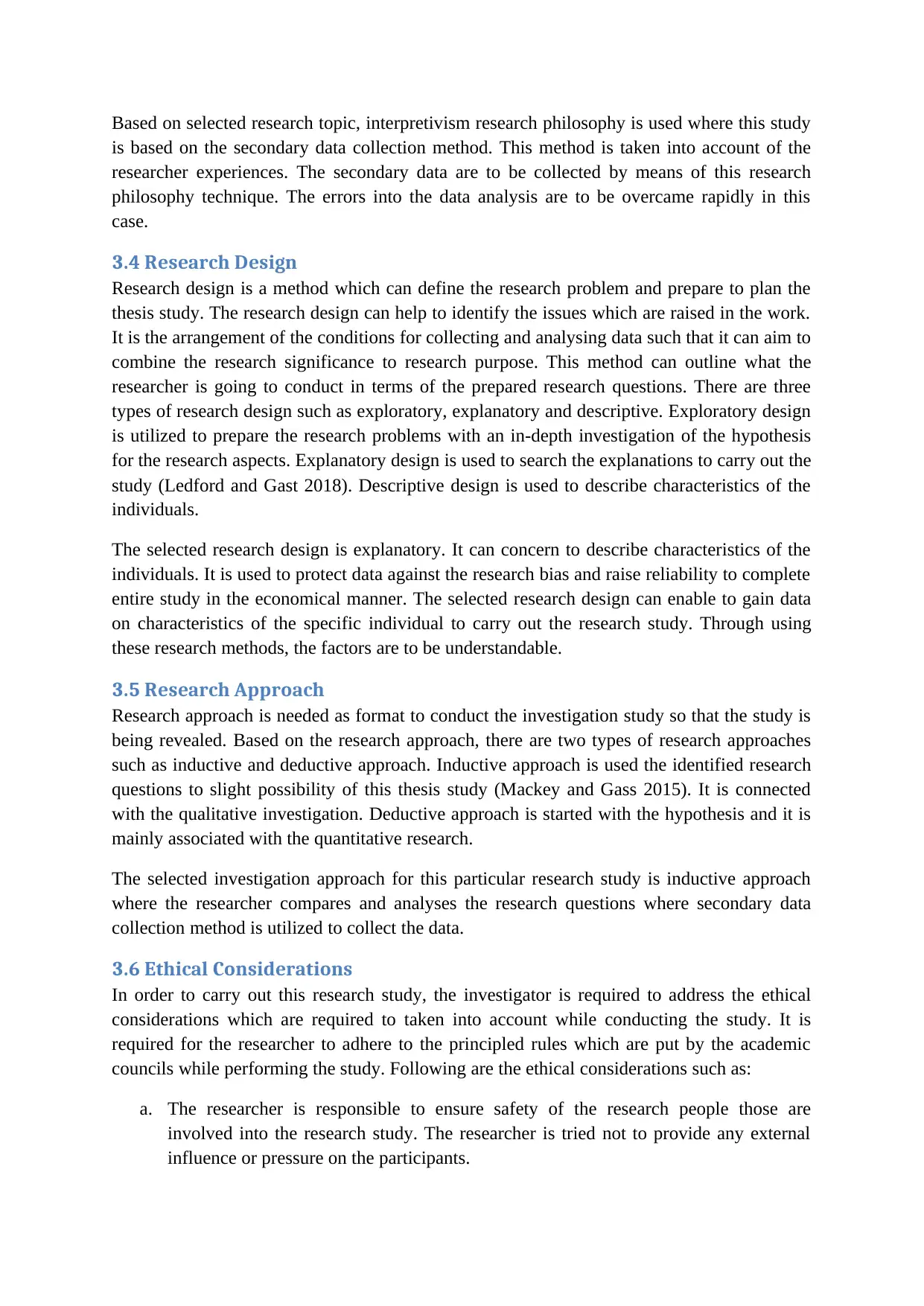
Based on selected research topic, interpretivism research philosophy is used where this study
is based on the secondary data collection method. This method is taken into account of the
researcher experiences. The secondary data are to be collected by means of this research
philosophy technique. The errors into the data analysis are to be overcame rapidly in this
case.
3.4 Research Design
Research design is a method which can define the research problem and prepare to plan the
thesis study. The research design can help to identify the issues which are raised in the work.
It is the arrangement of the conditions for collecting and analysing data such that it can aim to
combine the research significance to research purpose. This method can outline what the
researcher is going to conduct in terms of the prepared research questions. There are three
types of research design such as exploratory, explanatory and descriptive. Exploratory design
is utilized to prepare the research problems with an in-depth investigation of the hypothesis
for the research aspects. Explanatory design is used to search the explanations to carry out the
study (Ledford and Gast 2018). Descriptive design is used to describe characteristics of the
individuals.
The selected research design is explanatory. It can concern to describe characteristics of the
individuals. It is used to protect data against the research bias and raise reliability to complete
entire study in the economical manner. The selected research design can enable to gain data
on characteristics of the specific individual to carry out the research study. Through using
these research methods, the factors are to be understandable.
3.5 Research Approach
Research approach is needed as format to conduct the investigation study so that the study is
being revealed. Based on the research approach, there are two types of research approaches
such as inductive and deductive approach. Inductive approach is used the identified research
questions to slight possibility of this thesis study (Mackey and Gass 2015). It is connected
with the qualitative investigation. Deductive approach is started with the hypothesis and it is
mainly associated with the quantitative research.
The selected investigation approach for this particular research study is inductive approach
where the researcher compares and analyses the research questions where secondary data
collection method is utilized to collect the data.
3.6 Ethical Considerations
In order to carry out this research study, the investigator is required to address the ethical
considerations which are required to taken into account while conducting the study. It is
required for the researcher to adhere to the principled rules which are put by the academic
councils while performing the study. Following are the ethical considerations such as:
a. The researcher is responsible to ensure safety of the research people those are
involved into the research study. The researcher is tried not to provide any external
influence or pressure on the participants.
is based on the secondary data collection method. This method is taken into account of the
researcher experiences. The secondary data are to be collected by means of this research
philosophy technique. The errors into the data analysis are to be overcame rapidly in this
case.
3.4 Research Design
Research design is a method which can define the research problem and prepare to plan the
thesis study. The research design can help to identify the issues which are raised in the work.
It is the arrangement of the conditions for collecting and analysing data such that it can aim to
combine the research significance to research purpose. This method can outline what the
researcher is going to conduct in terms of the prepared research questions. There are three
types of research design such as exploratory, explanatory and descriptive. Exploratory design
is utilized to prepare the research problems with an in-depth investigation of the hypothesis
for the research aspects. Explanatory design is used to search the explanations to carry out the
study (Ledford and Gast 2018). Descriptive design is used to describe characteristics of the
individuals.
The selected research design is explanatory. It can concern to describe characteristics of the
individuals. It is used to protect data against the research bias and raise reliability to complete
entire study in the economical manner. The selected research design can enable to gain data
on characteristics of the specific individual to carry out the research study. Through using
these research methods, the factors are to be understandable.
3.5 Research Approach
Research approach is needed as format to conduct the investigation study so that the study is
being revealed. Based on the research approach, there are two types of research approaches
such as inductive and deductive approach. Inductive approach is used the identified research
questions to slight possibility of this thesis study (Mackey and Gass 2015). It is connected
with the qualitative investigation. Deductive approach is started with the hypothesis and it is
mainly associated with the quantitative research.
The selected investigation approach for this particular research study is inductive approach
where the researcher compares and analyses the research questions where secondary data
collection method is utilized to collect the data.
3.6 Ethical Considerations
In order to carry out this research study, the investigator is required to address the ethical
considerations which are required to taken into account while conducting the study. It is
required for the researcher to adhere to the principled rules which are put by the academic
councils while performing the study. Following are the ethical considerations such as:
a. The researcher is responsible to ensure safety of the research people those are
involved into the research study. The researcher is tried not to provide any external
influence or pressure on the participants.

b. It is required to maintain data transparency or information which are obtained while
conducting this particular research study.
3.7 Summary
This section is described different research methods and tools which help to get better
understanding of selected research topic. The researcher is tried to support nature of this
particular study with existing research methods so that a better research related procedures is
being outlined. The selected methods are used to analyse concepts related to efficient
resource management into the cloud computing. The researcher can quickly collected the data
so that the research problems are solved and research questions are being answered.
conducting this particular research study.
3.7 Summary
This section is described different research methods and tools which help to get better
understanding of selected research topic. The researcher is tried to support nature of this
particular study with existing research methods so that a better research related procedures is
being outlined. The selected methods are used to analyse concepts related to efficient
resource management into the cloud computing. The researcher can quickly collected the data
so that the research problems are solved and research questions are being answered.
Paraphrase This Document
Need a fresh take? Get an instant paraphrase of this document with our AI Paraphraser

4. Experiments
4.1 Introduction
Data experiments are consisted of data collection and data analysis methods which are
defined set of the information considered useful for implementation of the research project.
The information is to be collected throughout the research paper by means of peer review
journal articles based on managing resources in cloud computing. The data are considered as
useful information which is helpful to get better understanding of the research topic. It helps
to provide the researcher with accurate results plus enables the standard format of the
research work.
4.2 Experimental design
In this study, experimental design is conducted by collecting data from the scholarly articles
based on resource management in the cloud computing. It helps to explain the framework of
selected research topic which will help to collect as well as analyse the research work.
Throughout procedure of the data collection, design is being functional in improved
explanation of the methods which would provide quality data to the researcher. The
experimental design will help to perform academic research. It helps to provide various ideas
as well as thoughts which are required to complete entire thesis paper. It describes the
incidents as well as events corresponding to be happened. Throughout the methods, the
resource management issues into the cloud computing are identified and various resource
management techniques are also analyzed in this paper so that all the identified issues are to
be mitigated. It aims to gain details to state occurrence of the research events which are
proving details of the selected topic. Through this method, the resource management
techniques are addressed so that all the problems which are identified are overcame and the
reader can understand the motive behind the research study conducted on selected topic.
4.3 Data collection
The data collection is helpful to extract the information based on resource management in the
cloud computing based on the investigation requirements. While conducting research on
selected research topic, the data is being accounted as significant information required
collecting data on resource management in IaaS cloud. The data are to be collected by means
of two methods such as primary as well as secondary data methods. The primary data are
collected by means of survey and questionnaire methods. The primary data collection method
can incorporate the information from research participants throughout their responses. The
other primary approaches are interview, observations and survey. Secondary data method is
used to collect set of the information published into books, peer review articles and others.
In this particular study, secondary data collection method is required for the project and it is
collected from the papers and articles those are analysing the research problem. There are
total 20 peer review articles are taken into considerations for this existing research work
which are identified to be suitable research papers for effective management of resources in
IaaS cloud or cloud computing. In those papers, the results are analysed based on resource
4.1 Introduction
Data experiments are consisted of data collection and data analysis methods which are
defined set of the information considered useful for implementation of the research project.
The information is to be collected throughout the research paper by means of peer review
journal articles based on managing resources in cloud computing. The data are considered as
useful information which is helpful to get better understanding of the research topic. It helps
to provide the researcher with accurate results plus enables the standard format of the
research work.
4.2 Experimental design
In this study, experimental design is conducted by collecting data from the scholarly articles
based on resource management in the cloud computing. It helps to explain the framework of
selected research topic which will help to collect as well as analyse the research work.
Throughout procedure of the data collection, design is being functional in improved
explanation of the methods which would provide quality data to the researcher. The
experimental design will help to perform academic research. It helps to provide various ideas
as well as thoughts which are required to complete entire thesis paper. It describes the
incidents as well as events corresponding to be happened. Throughout the methods, the
resource management issues into the cloud computing are identified and various resource
management techniques are also analyzed in this paper so that all the identified issues are to
be mitigated. It aims to gain details to state occurrence of the research events which are
proving details of the selected topic. Through this method, the resource management
techniques are addressed so that all the problems which are identified are overcame and the
reader can understand the motive behind the research study conducted on selected topic.
4.3 Data collection
The data collection is helpful to extract the information based on resource management in the
cloud computing based on the investigation requirements. While conducting research on
selected research topic, the data is being accounted as significant information required
collecting data on resource management in IaaS cloud. The data are to be collected by means
of two methods such as primary as well as secondary data methods. The primary data are
collected by means of survey and questionnaire methods. The primary data collection method
can incorporate the information from research participants throughout their responses. The
other primary approaches are interview, observations and survey. Secondary data method is
used to collect set of the information published into books, peer review articles and others.
In this particular study, secondary data collection method is required for the project and it is
collected from the papers and articles those are analysing the research problem. There are
total 20 peer review articles are taken into considerations for this existing research work
which are identified to be suitable research papers for effective management of resources in
IaaS cloud or cloud computing. In those papers, the results are analysed based on resource
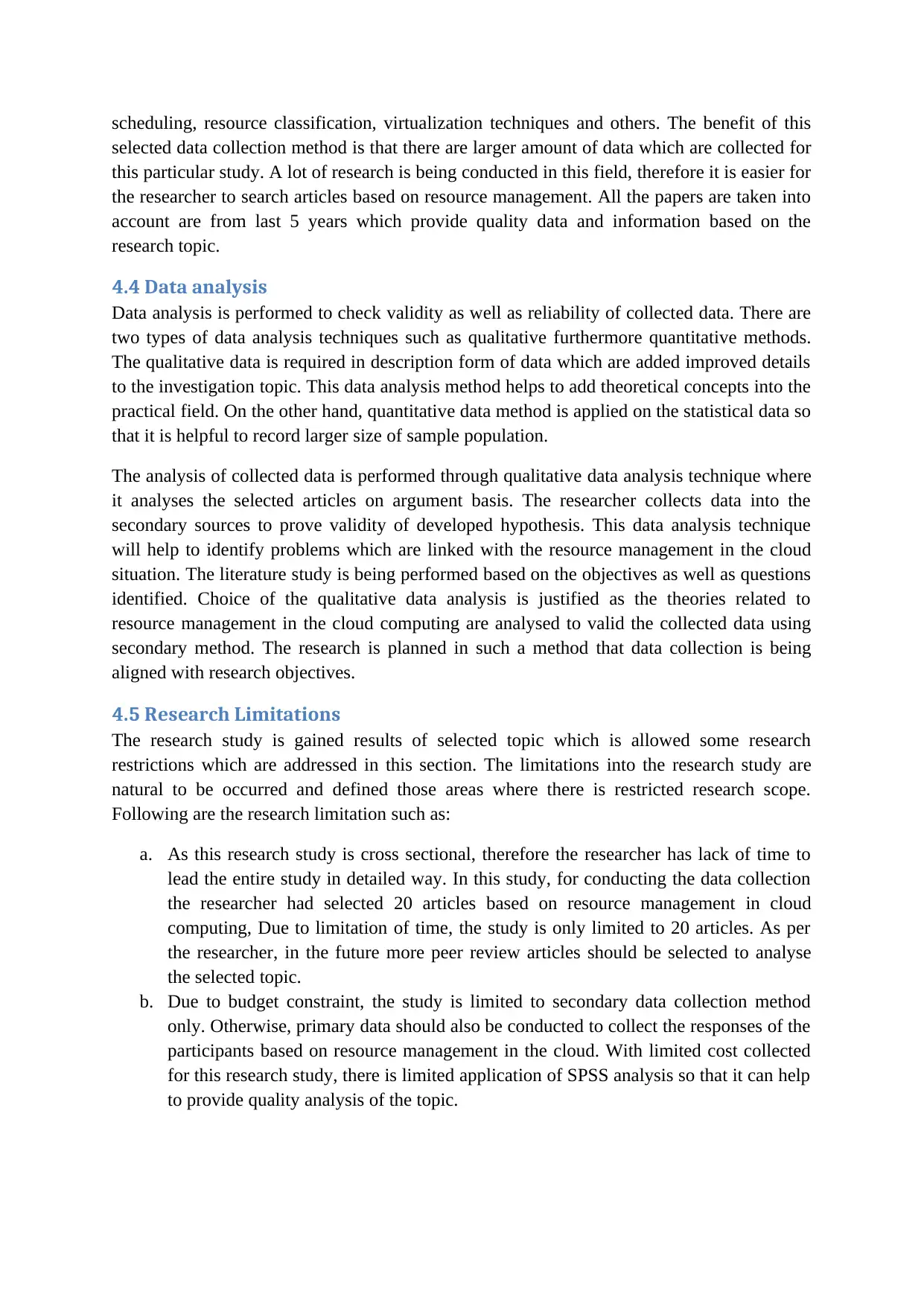
scheduling, resource classification, virtualization techniques and others. The benefit of this
selected data collection method is that there are larger amount of data which are collected for
this particular study. A lot of research is being conducted in this field, therefore it is easier for
the researcher to search articles based on resource management. All the papers are taken into
account are from last 5 years which provide quality data and information based on the
research topic.
4.4 Data analysis
Data analysis is performed to check validity as well as reliability of collected data. There are
two types of data analysis techniques such as qualitative furthermore quantitative methods.
The qualitative data is required in description form of data which are added improved details
to the investigation topic. This data analysis method helps to add theoretical concepts into the
practical field. On the other hand, quantitative data method is applied on the statistical data so
that it is helpful to record larger size of sample population.
The analysis of collected data is performed through qualitative data analysis technique where
it analyses the selected articles on argument basis. The researcher collects data into the
secondary sources to prove validity of developed hypothesis. This data analysis technique
will help to identify problems which are linked with the resource management in the cloud
situation. The literature study is being performed based on the objectives as well as questions
identified. Choice of the qualitative data analysis is justified as the theories related to
resource management in the cloud computing are analysed to valid the collected data using
secondary method. The research is planned in such a method that data collection is being
aligned with research objectives.
4.5 Research Limitations
The research study is gained results of selected topic which is allowed some research
restrictions which are addressed in this section. The limitations into the research study are
natural to be occurred and defined those areas where there is restricted research scope.
Following are the research limitation such as:
a. As this research study is cross sectional, therefore the researcher has lack of time to
lead the entire study in detailed way. In this study, for conducting the data collection
the researcher had selected 20 articles based on resource management in cloud
computing, Due to limitation of time, the study is only limited to 20 articles. As per
the researcher, in the future more peer review articles should be selected to analyse
the selected topic.
b. Due to budget constraint, the study is limited to secondary data collection method
only. Otherwise, primary data should also be conducted to collect the responses of the
participants based on resource management in the cloud. With limited cost collected
for this research study, there is limited application of SPSS analysis so that it can help
to provide quality analysis of the topic.
selected data collection method is that there are larger amount of data which are collected for
this particular study. A lot of research is being conducted in this field, therefore it is easier for
the researcher to search articles based on resource management. All the papers are taken into
account are from last 5 years which provide quality data and information based on the
research topic.
4.4 Data analysis
Data analysis is performed to check validity as well as reliability of collected data. There are
two types of data analysis techniques such as qualitative furthermore quantitative methods.
The qualitative data is required in description form of data which are added improved details
to the investigation topic. This data analysis method helps to add theoretical concepts into the
practical field. On the other hand, quantitative data method is applied on the statistical data so
that it is helpful to record larger size of sample population.
The analysis of collected data is performed through qualitative data analysis technique where
it analyses the selected articles on argument basis. The researcher collects data into the
secondary sources to prove validity of developed hypothesis. This data analysis technique
will help to identify problems which are linked with the resource management in the cloud
situation. The literature study is being performed based on the objectives as well as questions
identified. Choice of the qualitative data analysis is justified as the theories related to
resource management in the cloud computing are analysed to valid the collected data using
secondary method. The research is planned in such a method that data collection is being
aligned with research objectives.
4.5 Research Limitations
The research study is gained results of selected topic which is allowed some research
restrictions which are addressed in this section. The limitations into the research study are
natural to be occurred and defined those areas where there is restricted research scope.
Following are the research limitation such as:
a. As this research study is cross sectional, therefore the researcher has lack of time to
lead the entire study in detailed way. In this study, for conducting the data collection
the researcher had selected 20 articles based on resource management in cloud
computing, Due to limitation of time, the study is only limited to 20 articles. As per
the researcher, in the future more peer review articles should be selected to analyse
the selected topic.
b. Due to budget constraint, the study is limited to secondary data collection method
only. Otherwise, primary data should also be conducted to collect the responses of the
participants based on resource management in the cloud. With limited cost collected
for this research study, there is limited application of SPSS analysis so that it can help
to provide quality analysis of the topic.

4.6 Summary
This research study is prepared to provide the methods which are used to collect data based
on selected thesis topic, efficient resource management in IaaS cloud. The methodologies
provide clear understanding of entire study. The study is based on secondary method where
the data are to be collected from peer review articles. It is a method to collect as well as
analyse the data which are available and are not incorporated to collect data and information.
As the study is based on resource management, therefore data are published into the literature
as well as journal, which makes the study easier.
This research study is prepared to provide the methods which are used to collect data based
on selected thesis topic, efficient resource management in IaaS cloud. The methodologies
provide clear understanding of entire study. The study is based on secondary method where
the data are to be collected from peer review articles. It is a method to collect as well as
analyse the data which are available and are not incorporated to collect data and information.
As the study is based on resource management, therefore data are published into the literature
as well as journal, which makes the study easier.
Secure Best Marks with AI Grader
Need help grading? Try our AI Grader for instant feedback on your assignments.
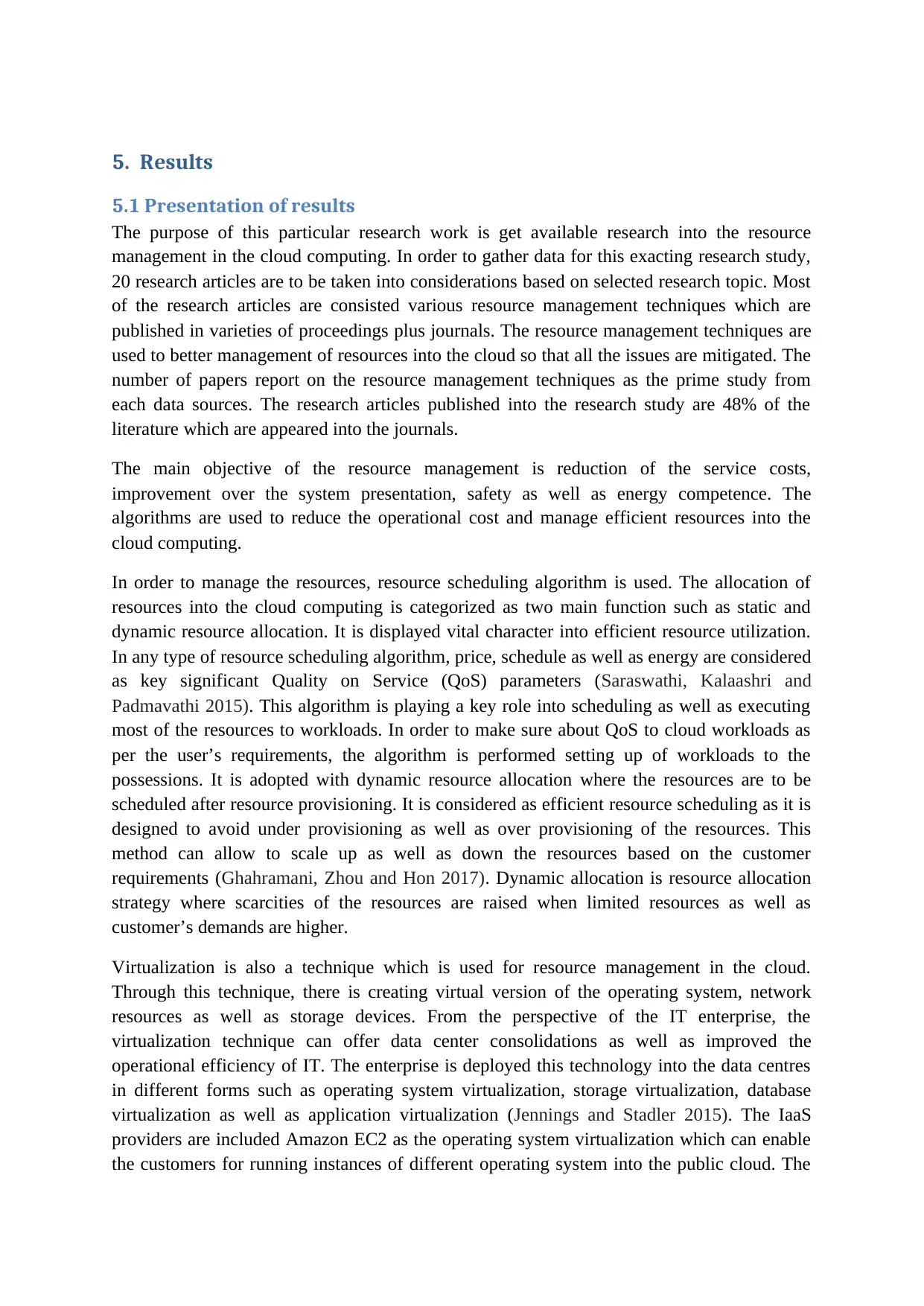
5. Results
5.1 Presentation of results
The purpose of this particular research work is get available research into the resource
management in the cloud computing. In order to gather data for this exacting research study,
20 research articles are to be taken into considerations based on selected research topic. Most
of the research articles are consisted various resource management techniques which are
published in varieties of proceedings plus journals. The resource management techniques are
used to better management of resources into the cloud so that all the issues are mitigated. The
number of papers report on the resource management techniques as the prime study from
each data sources. The research articles published into the research study are 48% of the
literature which are appeared into the journals.
The main objective of the resource management is reduction of the service costs,
improvement over the system presentation, safety as well as energy competence. The
algorithms are used to reduce the operational cost and manage efficient resources into the
cloud computing.
In order to manage the resources, resource scheduling algorithm is used. The allocation of
resources into the cloud computing is categorized as two main function such as static and
dynamic resource allocation. It is displayed vital character into efficient resource utilization.
In any type of resource scheduling algorithm, price, schedule as well as energy are considered
as key significant Quality on Service (QoS) parameters (Saraswathi, Kalaashri and
Padmavathi 2015). This algorithm is playing a key role into scheduling as well as executing
most of the resources to workloads. In order to make sure about QoS to cloud workloads as
per the user’s requirements, the algorithm is performed setting up of workloads to the
possessions. It is adopted with dynamic resource allocation where the resources are to be
scheduled after resource provisioning. It is considered as efficient resource scheduling as it is
designed to avoid under provisioning as well as over provisioning of the resources. This
method can allow to scale up as well as down the resources based on the customer
requirements (Ghahramani, Zhou and Hon 2017). Dynamic allocation is resource allocation
strategy where scarcities of the resources are raised when limited resources as well as
customer’s demands are higher.
Virtualization is also a technique which is used for resource management in the cloud.
Through this technique, there is creating virtual version of the operating system, network
resources as well as storage devices. From the perspective of the IT enterprise, the
virtualization technique can offer data center consolidations as well as improved the
operational efficiency of IT. The enterprise is deployed this technology into the data centres
in different forms such as operating system virtualization, storage virtualization, database
virtualization as well as application virtualization (Jennings and Stadler 2015). The IaaS
providers are included Amazon EC2 as the operating system virtualization which can enable
the customers for running instances of different operating system into the public cloud. The
5.1 Presentation of results
The purpose of this particular research work is get available research into the resource
management in the cloud computing. In order to gather data for this exacting research study,
20 research articles are to be taken into considerations based on selected research topic. Most
of the research articles are consisted various resource management techniques which are
published in varieties of proceedings plus journals. The resource management techniques are
used to better management of resources into the cloud so that all the issues are mitigated. The
number of papers report on the resource management techniques as the prime study from
each data sources. The research articles published into the research study are 48% of the
literature which are appeared into the journals.
The main objective of the resource management is reduction of the service costs,
improvement over the system presentation, safety as well as energy competence. The
algorithms are used to reduce the operational cost and manage efficient resources into the
cloud computing.
In order to manage the resources, resource scheduling algorithm is used. The allocation of
resources into the cloud computing is categorized as two main function such as static and
dynamic resource allocation. It is displayed vital character into efficient resource utilization.
In any type of resource scheduling algorithm, price, schedule as well as energy are considered
as key significant Quality on Service (QoS) parameters (Saraswathi, Kalaashri and
Padmavathi 2015). This algorithm is playing a key role into scheduling as well as executing
most of the resources to workloads. In order to make sure about QoS to cloud workloads as
per the user’s requirements, the algorithm is performed setting up of workloads to the
possessions. It is adopted with dynamic resource allocation where the resources are to be
scheduled after resource provisioning. It is considered as efficient resource scheduling as it is
designed to avoid under provisioning as well as over provisioning of the resources. This
method can allow to scale up as well as down the resources based on the customer
requirements (Ghahramani, Zhou and Hon 2017). Dynamic allocation is resource allocation
strategy where scarcities of the resources are raised when limited resources as well as
customer’s demands are higher.
Virtualization is also a technique which is used for resource management in the cloud.
Through this technique, there is creating virtual version of the operating system, network
resources as well as storage devices. From the perspective of the IT enterprise, the
virtualization technique can offer data center consolidations as well as improved the
operational efficiency of IT. The enterprise is deployed this technology into the data centres
in different forms such as operating system virtualization, storage virtualization, database
virtualization as well as application virtualization (Jennings and Stadler 2015). The IaaS
providers are included Amazon EC2 as the operating system virtualization which can enable
the customers for running instances of different operating system into the public cloud. The
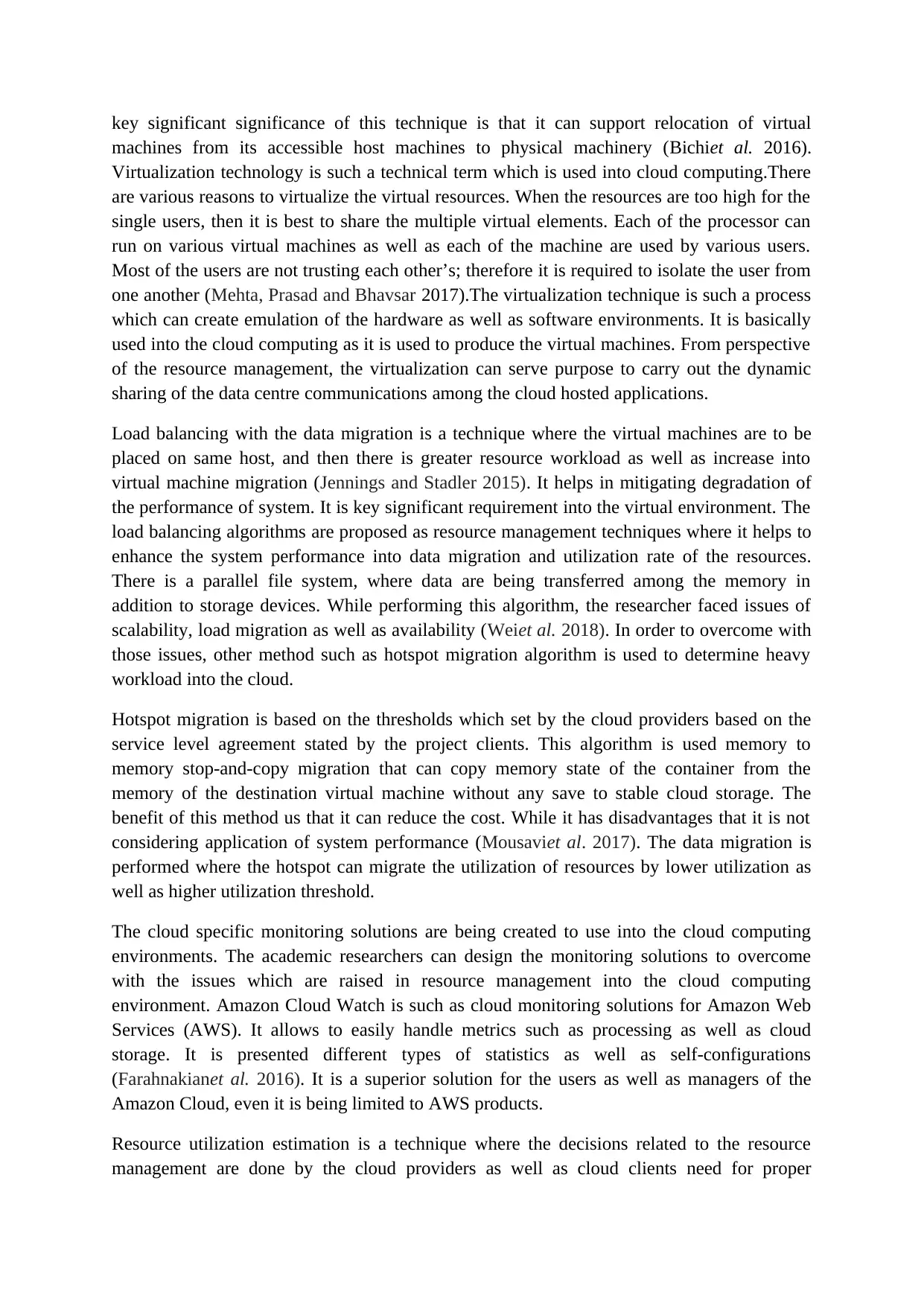
key significant significance of this technique is that it can support relocation of virtual
machines from its accessible host machines to physical machinery (Bichiet al. 2016).
Virtualization technology is such a technical term which is used into cloud computing.There
are various reasons to virtualize the virtual resources. When the resources are too high for the
single users, then it is best to share the multiple virtual elements. Each of the processor can
run on various virtual machines as well as each of the machine are used by various users.
Most of the users are not trusting each other’s; therefore it is required to isolate the user from
one another (Mehta, Prasad and Bhavsar 2017).The virtualization technique is such a process
which can create emulation of the hardware as well as software environments. It is basically
used into the cloud computing as it is used to produce the virtual machines. From perspective
of the resource management, the virtualization can serve purpose to carry out the dynamic
sharing of the data centre communications among the cloud hosted applications.
Load balancing with the data migration is a technique where the virtual machines are to be
placed on same host, and then there is greater resource workload as well as increase into
virtual machine migration (Jennings and Stadler 2015). It helps in mitigating degradation of
the performance of system. It is key significant requirement into the virtual environment. The
load balancing algorithms are proposed as resource management techniques where it helps to
enhance the system performance into data migration and utilization rate of the resources.
There is a parallel file system, where data are being transferred among the memory in
addition to storage devices. While performing this algorithm, the researcher faced issues of
scalability, load migration as well as availability (Weiet al. 2018). In order to overcome with
those issues, other method such as hotspot migration algorithm is used to determine heavy
workload into the cloud.
Hotspot migration is based on the thresholds which set by the cloud providers based on the
service level agreement stated by the project clients. This algorithm is used memory to
memory stop-and-copy migration that can copy memory state of the container from the
memory of the destination virtual machine without any save to stable cloud storage. The
benefit of this method us that it can reduce the cost. While it has disadvantages that it is not
considering application of system performance (Mousaviet al. 2017). The data migration is
performed where the hotspot can migrate the utilization of resources by lower utilization as
well as higher utilization threshold.
The cloud specific monitoring solutions are being created to use into the cloud computing
environments. The academic researchers can design the monitoring solutions to overcome
with the issues which are raised in resource management into the cloud computing
environment. Amazon Cloud Watch is such as cloud monitoring solutions for Amazon Web
Services (AWS). It allows to easily handle metrics such as processing as well as cloud
storage. It is presented different types of statistics as well as self-configurations
(Farahnakianet al. 2016). It is a superior solution for the users as well as managers of the
Amazon Cloud, even it is being limited to AWS products.
Resource utilization estimation is a technique where the decisions related to the resource
management are done by the cloud providers as well as cloud clients need for proper
machines from its accessible host machines to physical machinery (Bichiet al. 2016).
Virtualization technology is such a technical term which is used into cloud computing.There
are various reasons to virtualize the virtual resources. When the resources are too high for the
single users, then it is best to share the multiple virtual elements. Each of the processor can
run on various virtual machines as well as each of the machine are used by various users.
Most of the users are not trusting each other’s; therefore it is required to isolate the user from
one another (Mehta, Prasad and Bhavsar 2017).The virtualization technique is such a process
which can create emulation of the hardware as well as software environments. It is basically
used into the cloud computing as it is used to produce the virtual machines. From perspective
of the resource management, the virtualization can serve purpose to carry out the dynamic
sharing of the data centre communications among the cloud hosted applications.
Load balancing with the data migration is a technique where the virtual machines are to be
placed on same host, and then there is greater resource workload as well as increase into
virtual machine migration (Jennings and Stadler 2015). It helps in mitigating degradation of
the performance of system. It is key significant requirement into the virtual environment. The
load balancing algorithms are proposed as resource management techniques where it helps to
enhance the system performance into data migration and utilization rate of the resources.
There is a parallel file system, where data are being transferred among the memory in
addition to storage devices. While performing this algorithm, the researcher faced issues of
scalability, load migration as well as availability (Weiet al. 2018). In order to overcome with
those issues, other method such as hotspot migration algorithm is used to determine heavy
workload into the cloud.
Hotspot migration is based on the thresholds which set by the cloud providers based on the
service level agreement stated by the project clients. This algorithm is used memory to
memory stop-and-copy migration that can copy memory state of the container from the
memory of the destination virtual machine without any save to stable cloud storage. The
benefit of this method us that it can reduce the cost. While it has disadvantages that it is not
considering application of system performance (Mousaviet al. 2017). The data migration is
performed where the hotspot can migrate the utilization of resources by lower utilization as
well as higher utilization threshold.
The cloud specific monitoring solutions are being created to use into the cloud computing
environments. The academic researchers can design the monitoring solutions to overcome
with the issues which are raised in resource management into the cloud computing
environment. Amazon Cloud Watch is such as cloud monitoring solutions for Amazon Web
Services (AWS). It allows to easily handle metrics such as processing as well as cloud
storage. It is presented different types of statistics as well as self-configurations
(Farahnakianet al. 2016). It is a superior solution for the users as well as managers of the
Amazon Cloud, even it is being limited to AWS products.
Resource utilization estimation is a technique where the decisions related to the resource
management are done by the cloud providers as well as cloud clients need for proper
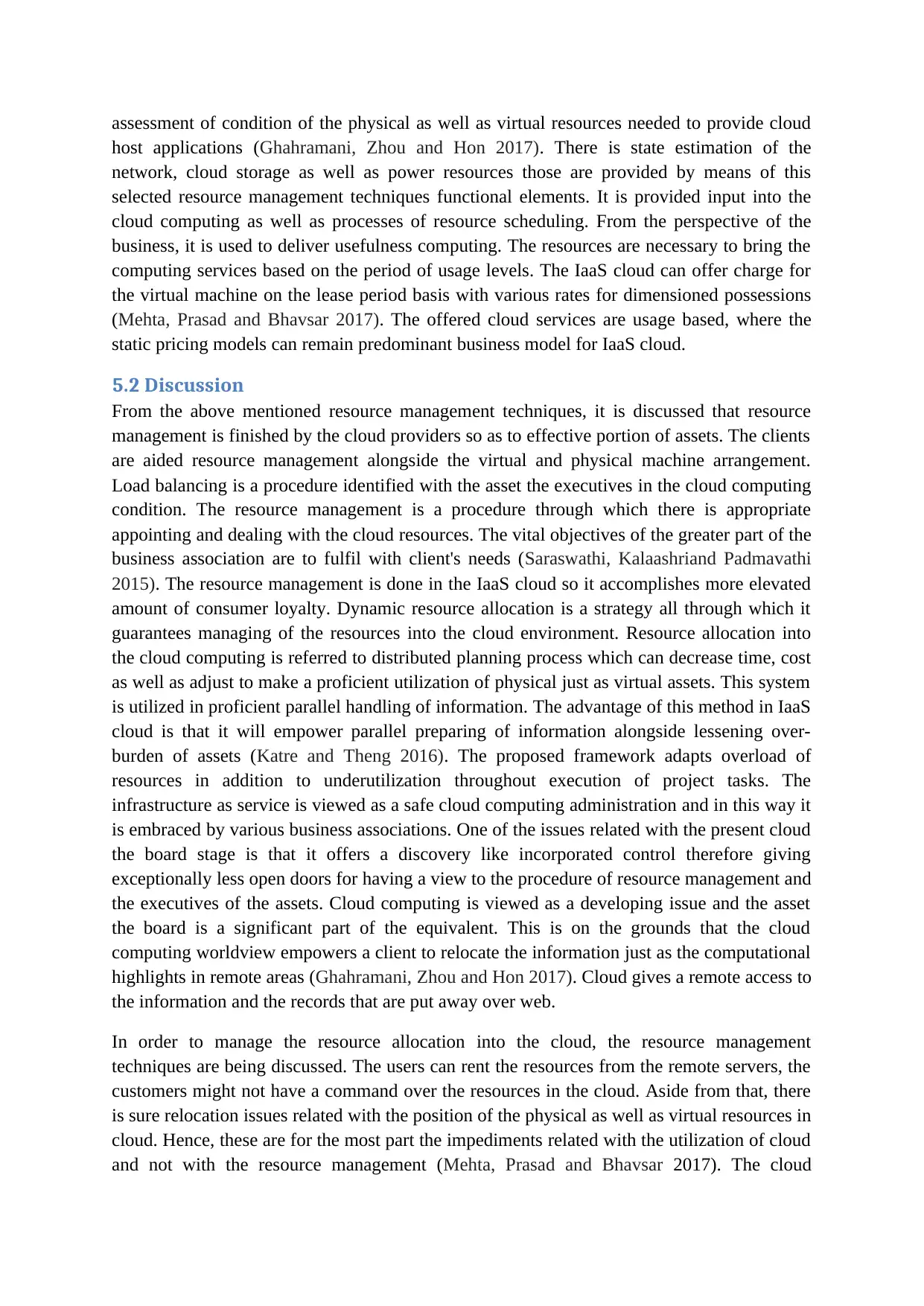
assessment of condition of the physical as well as virtual resources needed to provide cloud
host applications (Ghahramani, Zhou and Hon 2017). There is state estimation of the
network, cloud storage as well as power resources those are provided by means of this
selected resource management techniques functional elements. It is provided input into the
cloud computing as well as processes of resource scheduling. From the perspective of the
business, it is used to deliver usefulness computing. The resources are necessary to bring the
computing services based on the period of usage levels. The IaaS cloud can offer charge for
the virtual machine on the lease period basis with various rates for dimensioned possessions
(Mehta, Prasad and Bhavsar 2017). The offered cloud services are usage based, where the
static pricing models can remain predominant business model for IaaS cloud.
5.2 Discussion
From the above mentioned resource management techniques, it is discussed that resource
management is finished by the cloud providers so as to effective portion of assets. The clients
are aided resource management alongside the virtual and physical machine arrangement.
Load balancing is a procedure identified with the asset the executives in the cloud computing
condition. The resource management is a procedure through which there is appropriate
appointing and dealing with the cloud resources. The vital objectives of the greater part of the
business association are to fulfil with client's needs (Saraswathi, Kalaashriand Padmavathi
2015). The resource management is done in the IaaS cloud so it accomplishes more elevated
amount of consumer loyalty. Dynamic resource allocation is a strategy all through which it
guarantees managing of the resources into the cloud environment. Resource allocation into
the cloud computing is referred to distributed planning process which can decrease time, cost
as well as adjust to make a proficient utilization of physical just as virtual assets. This system
is utilized in proficient parallel handling of information. The advantage of this method in IaaS
cloud is that it will empower parallel preparing of information alongside lessening over-
burden of assets (Katre and Theng 2016). The proposed framework adapts overload of
resources in addition to underutilization throughout execution of project tasks. The
infrastructure as service is viewed as a safe cloud computing administration and in this way it
is embraced by various business associations. One of the issues related with the present cloud
the board stage is that it offers a discovery like incorporated control therefore giving
exceptionally less open doors for having a view to the procedure of resource management and
the executives of the assets. Cloud computing is viewed as a developing issue and the asset
the board is a significant part of the equivalent. This is on the grounds that the cloud
computing worldview empowers a client to relocate the information just as the computational
highlights in remote areas (Ghahramani, Zhou and Hon 2017). Cloud gives a remote access to
the information and the records that are put away over web.
In order to manage the resource allocation into the cloud, the resource management
techniques are being discussed. The users can rent the resources from the remote servers, the
customers might not have a command over the resources in the cloud. Aside from that, there
is sure relocation issues related with the position of the physical as well as virtual resources in
cloud. Hence, these are for the most part the impediments related with the utilization of cloud
and not with the resource management (Mehta, Prasad and Bhavsar 2017). The cloud
host applications (Ghahramani, Zhou and Hon 2017). There is state estimation of the
network, cloud storage as well as power resources those are provided by means of this
selected resource management techniques functional elements. It is provided input into the
cloud computing as well as processes of resource scheduling. From the perspective of the
business, it is used to deliver usefulness computing. The resources are necessary to bring the
computing services based on the period of usage levels. The IaaS cloud can offer charge for
the virtual machine on the lease period basis with various rates for dimensioned possessions
(Mehta, Prasad and Bhavsar 2017). The offered cloud services are usage based, where the
static pricing models can remain predominant business model for IaaS cloud.
5.2 Discussion
From the above mentioned resource management techniques, it is discussed that resource
management is finished by the cloud providers so as to effective portion of assets. The clients
are aided resource management alongside the virtual and physical machine arrangement.
Load balancing is a procedure identified with the asset the executives in the cloud computing
condition. The resource management is a procedure through which there is appropriate
appointing and dealing with the cloud resources. The vital objectives of the greater part of the
business association are to fulfil with client's needs (Saraswathi, Kalaashriand Padmavathi
2015). The resource management is done in the IaaS cloud so it accomplishes more elevated
amount of consumer loyalty. Dynamic resource allocation is a strategy all through which it
guarantees managing of the resources into the cloud environment. Resource allocation into
the cloud computing is referred to distributed planning process which can decrease time, cost
as well as adjust to make a proficient utilization of physical just as virtual assets. This system
is utilized in proficient parallel handling of information. The advantage of this method in IaaS
cloud is that it will empower parallel preparing of information alongside lessening over-
burden of assets (Katre and Theng 2016). The proposed framework adapts overload of
resources in addition to underutilization throughout execution of project tasks. The
infrastructure as service is viewed as a safe cloud computing administration and in this way it
is embraced by various business associations. One of the issues related with the present cloud
the board stage is that it offers a discovery like incorporated control therefore giving
exceptionally less open doors for having a view to the procedure of resource management and
the executives of the assets. Cloud computing is viewed as a developing issue and the asset
the board is a significant part of the equivalent. This is on the grounds that the cloud
computing worldview empowers a client to relocate the information just as the computational
highlights in remote areas (Ghahramani, Zhou and Hon 2017). Cloud gives a remote access to
the information and the records that are put away over web.
In order to manage the resource allocation into the cloud, the resource management
techniques are being discussed. The users can rent the resources from the remote servers, the
customers might not have a command over the resources in the cloud. Aside from that, there
is sure relocation issues related with the position of the physical as well as virtual resources in
cloud. Hence, these are for the most part the impediments related with the utilization of cloud
and not with the resource management (Mehta, Prasad and Bhavsar 2017). The cloud
Paraphrase This Document
Need a fresh take? Get an instant paraphrase of this document with our AI Paraphraser
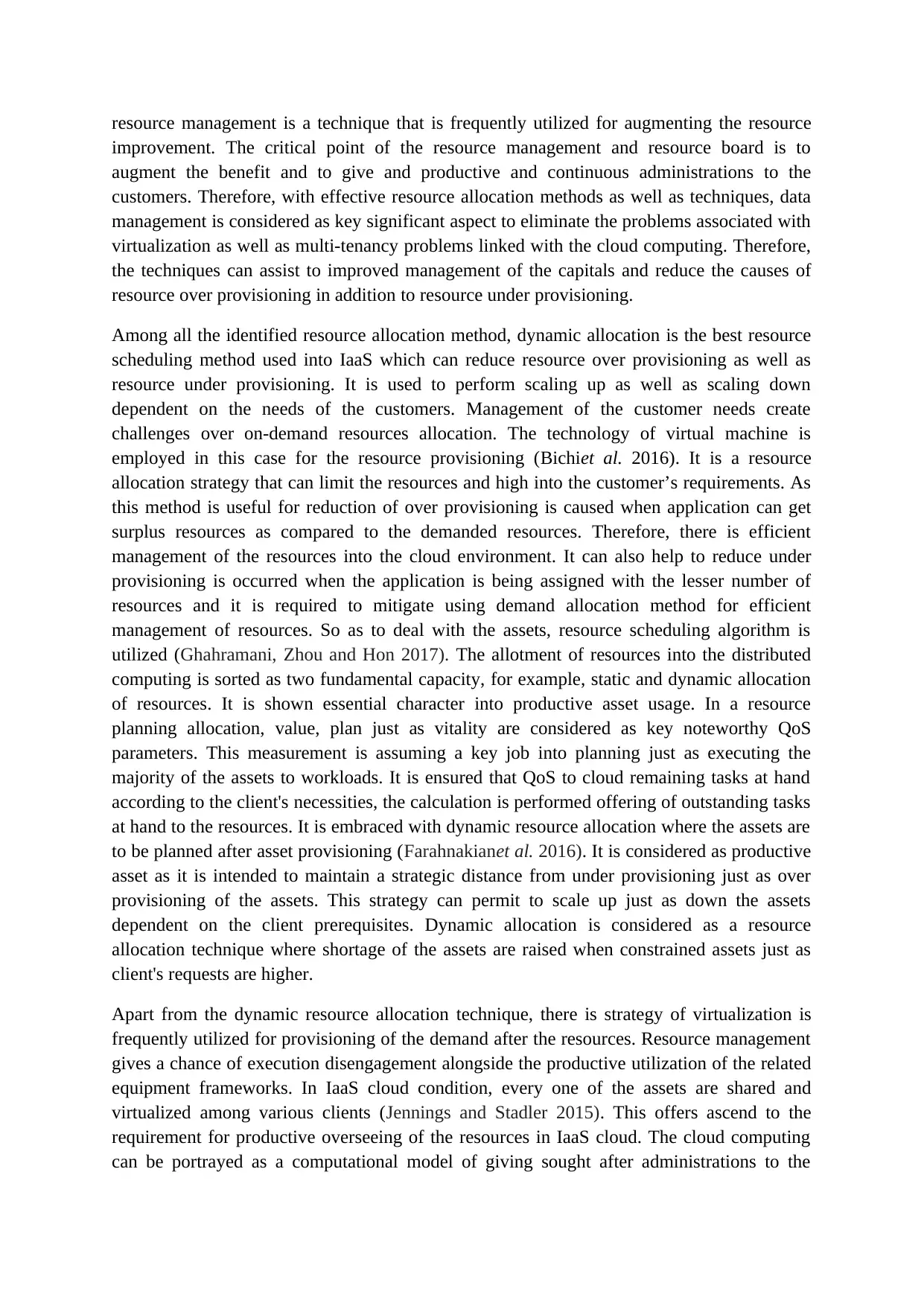
resource management is a technique that is frequently utilized for augmenting the resource
improvement. The critical point of the resource management and resource board is to
augment the benefit and to give and productive and continuous administrations to the
customers. Therefore, with effective resource allocation methods as well as techniques, data
management is considered as key significant aspect to eliminate the problems associated with
virtualization as well as multi-tenancy problems linked with the cloud computing. Therefore,
the techniques can assist to improved management of the capitals and reduce the causes of
resource over provisioning in addition to resource under provisioning.
Among all the identified resource allocation method, dynamic allocation is the best resource
scheduling method used into IaaS which can reduce resource over provisioning as well as
resource under provisioning. It is used to perform scaling up as well as scaling down
dependent on the needs of the customers. Management of the customer needs create
challenges over on-demand resources allocation. The technology of virtual machine is
employed in this case for the resource provisioning (Bichiet al. 2016). It is a resource
allocation strategy that can limit the resources and high into the customer’s requirements. As
this method is useful for reduction of over provisioning is caused when application can get
surplus resources as compared to the demanded resources. Therefore, there is efficient
management of the resources into the cloud environment. It can also help to reduce under
provisioning is occurred when the application is being assigned with the lesser number of
resources and it is required to mitigate using demand allocation method for efficient
management of resources. So as to deal with the assets, resource scheduling algorithm is
utilized (Ghahramani, Zhou and Hon 2017). The allotment of resources into the distributed
computing is sorted as two fundamental capacity, for example, static and dynamic allocation
of resources. It is shown essential character into productive asset usage. In a resource
planning allocation, value, plan just as vitality are considered as key noteworthy QoS
parameters. This measurement is assuming a key job into planning just as executing the
majority of the assets to workloads. It is ensured that QoS to cloud remaining tasks at hand
according to the client's necessities, the calculation is performed offering of outstanding tasks
at hand to the resources. It is embraced with dynamic resource allocation where the assets are
to be planned after asset provisioning (Farahnakianet al. 2016). It is considered as productive
asset as it is intended to maintain a strategic distance from under provisioning just as over
provisioning of the assets. This strategy can permit to scale up just as down the assets
dependent on the client prerequisites. Dynamic allocation is considered as a resource
allocation technique where shortage of the assets are raised when constrained assets just as
client's requests are higher.
Apart from the dynamic resource allocation technique, there is strategy of virtualization is
frequently utilized for provisioning of the demand after the resources. Resource management
gives a chance of execution disengagement alongside the productive utilization of the related
equipment frameworks. In IaaS cloud condition, every one of the assets are shared and
virtualized among various clients (Jennings and Stadler 2015). This offers ascend to the
requirement for productive overseeing of the resources in IaaS cloud. The cloud computing
can be portrayed as a computational model of giving sought after administrations to the
improvement. The critical point of the resource management and resource board is to
augment the benefit and to give and productive and continuous administrations to the
customers. Therefore, with effective resource allocation methods as well as techniques, data
management is considered as key significant aspect to eliminate the problems associated with
virtualization as well as multi-tenancy problems linked with the cloud computing. Therefore,
the techniques can assist to improved management of the capitals and reduce the causes of
resource over provisioning in addition to resource under provisioning.
Among all the identified resource allocation method, dynamic allocation is the best resource
scheduling method used into IaaS which can reduce resource over provisioning as well as
resource under provisioning. It is used to perform scaling up as well as scaling down
dependent on the needs of the customers. Management of the customer needs create
challenges over on-demand resources allocation. The technology of virtual machine is
employed in this case for the resource provisioning (Bichiet al. 2016). It is a resource
allocation strategy that can limit the resources and high into the customer’s requirements. As
this method is useful for reduction of over provisioning is caused when application can get
surplus resources as compared to the demanded resources. Therefore, there is efficient
management of the resources into the cloud environment. It can also help to reduce under
provisioning is occurred when the application is being assigned with the lesser number of
resources and it is required to mitigate using demand allocation method for efficient
management of resources. So as to deal with the assets, resource scheduling algorithm is
utilized (Ghahramani, Zhou and Hon 2017). The allotment of resources into the distributed
computing is sorted as two fundamental capacity, for example, static and dynamic allocation
of resources. It is shown essential character into productive asset usage. In a resource
planning allocation, value, plan just as vitality are considered as key noteworthy QoS
parameters. This measurement is assuming a key job into planning just as executing the
majority of the assets to workloads. It is ensured that QoS to cloud remaining tasks at hand
according to the client's necessities, the calculation is performed offering of outstanding tasks
at hand to the resources. It is embraced with dynamic resource allocation where the assets are
to be planned after asset provisioning (Farahnakianet al. 2016). It is considered as productive
asset as it is intended to maintain a strategic distance from under provisioning just as over
provisioning of the assets. This strategy can permit to scale up just as down the assets
dependent on the client prerequisites. Dynamic allocation is considered as a resource
allocation technique where shortage of the assets are raised when constrained assets just as
client's requests are higher.
Apart from the dynamic resource allocation technique, there is strategy of virtualization is
frequently utilized for provisioning of the demand after the resources. Resource management
gives a chance of execution disengagement alongside the productive utilization of the related
equipment frameworks. In IaaS cloud condition, every one of the assets are shared and
virtualized among various clients (Jennings and Stadler 2015). This offers ascend to the
requirement for productive overseeing of the resources in IaaS cloud. The cloud computing
can be portrayed as a computational model of giving sought after administrations to the
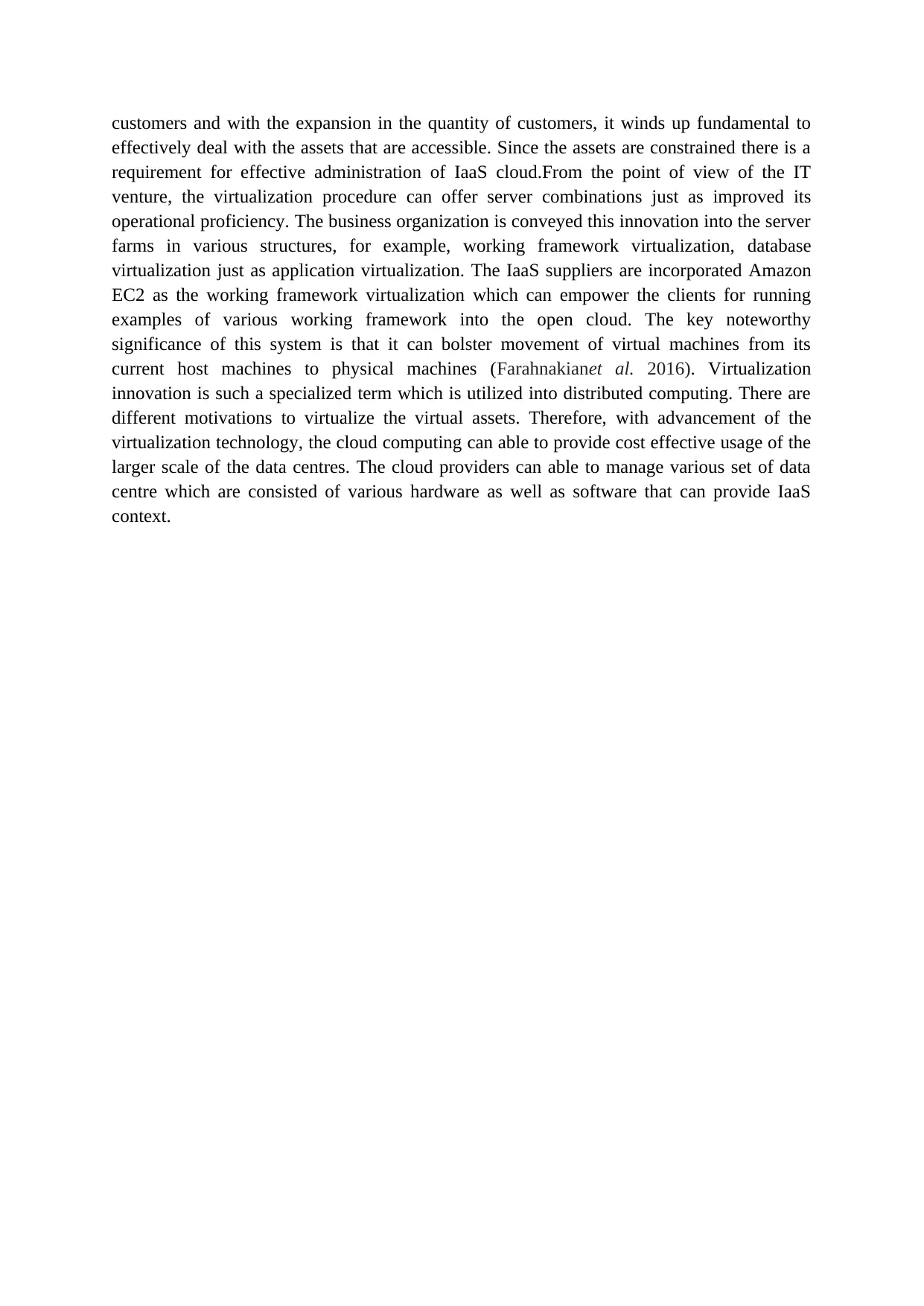
customers and with the expansion in the quantity of customers, it winds up fundamental to
effectively deal with the assets that are accessible. Since the assets are constrained there is a
requirement for effective administration of IaaS cloud.From the point of view of the IT
venture, the virtualization procedure can offer server combinations just as improved its
operational proficiency. The business organization is conveyed this innovation into the server
farms in various structures, for example, working framework virtualization, database
virtualization just as application virtualization. The IaaS suppliers are incorporated Amazon
EC2 as the working framework virtualization which can empower the clients for running
examples of various working framework into the open cloud. The key noteworthy
significance of this system is that it can bolster movement of virtual machines from its
current host machines to physical machines (Farahnakianet al. 2016). Virtualization
innovation is such a specialized term which is utilized into distributed computing. There are
different motivations to virtualize the virtual assets. Therefore, with advancement of the
virtualization technology, the cloud computing can able to provide cost effective usage of the
larger scale of the data centres. The cloud providers can able to manage various set of data
centre which are consisted of various hardware as well as software that can provide IaaS
context.
effectively deal with the assets that are accessible. Since the assets are constrained there is a
requirement for effective administration of IaaS cloud.From the point of view of the IT
venture, the virtualization procedure can offer server combinations just as improved its
operational proficiency. The business organization is conveyed this innovation into the server
farms in various structures, for example, working framework virtualization, database
virtualization just as application virtualization. The IaaS suppliers are incorporated Amazon
EC2 as the working framework virtualization which can empower the clients for running
examples of various working framework into the open cloud. The key noteworthy
significance of this system is that it can bolster movement of virtual machines from its
current host machines to physical machines (Farahnakianet al. 2016). Virtualization
innovation is such a specialized term which is utilized into distributed computing. There are
different motivations to virtualize the virtual assets. Therefore, with advancement of the
virtualization technology, the cloud computing can able to provide cost effective usage of the
larger scale of the data centres. The cloud providers can able to manage various set of data
centre which are consisted of various hardware as well as software that can provide IaaS
context.
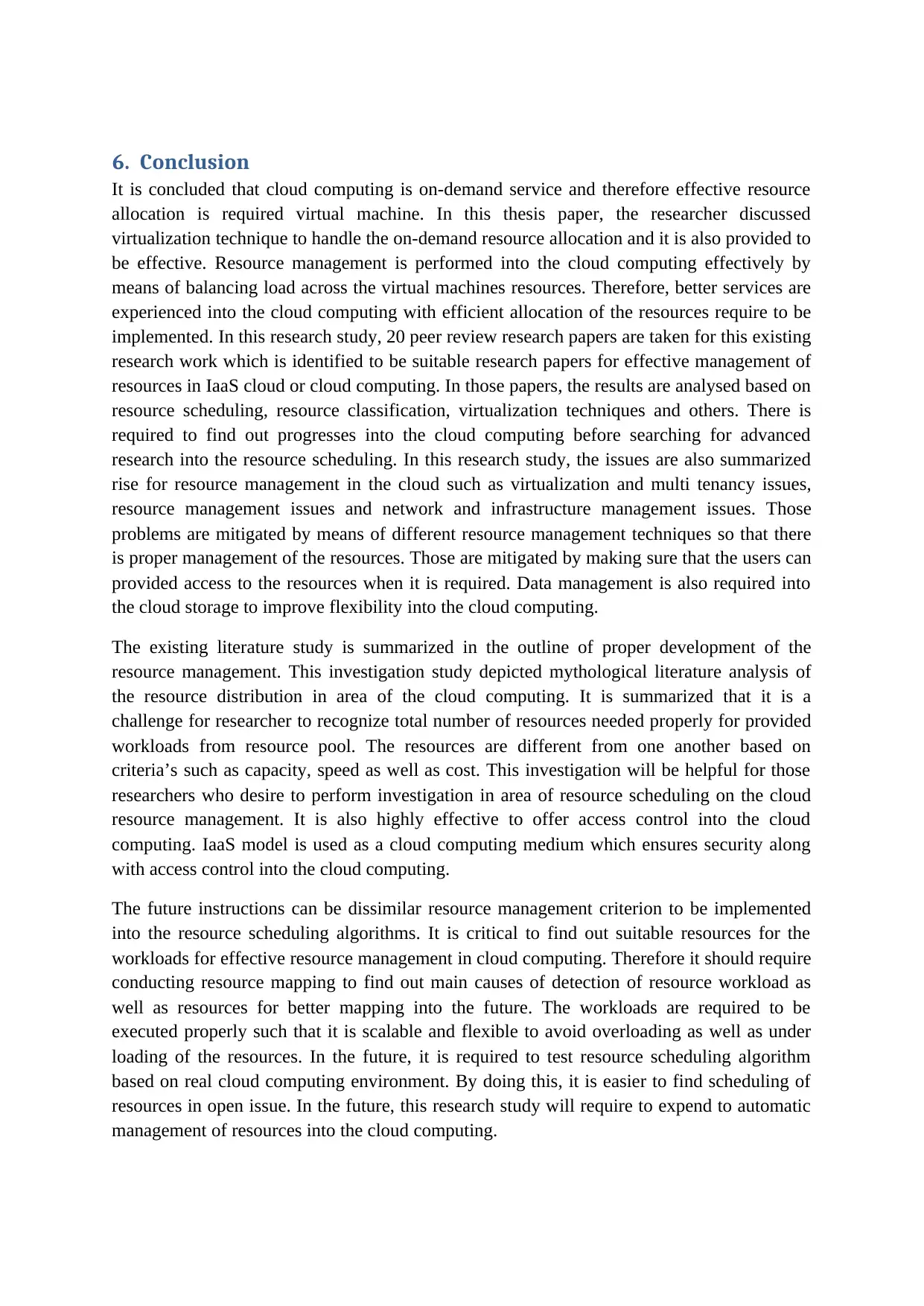
6. Conclusion
It is concluded that cloud computing is on-demand service and therefore effective resource
allocation is required virtual machine. In this thesis paper, the researcher discussed
virtualization technique to handle the on-demand resource allocation and it is also provided to
be effective. Resource management is performed into the cloud computing effectively by
means of balancing load across the virtual machines resources. Therefore, better services are
experienced into the cloud computing with efficient allocation of the resources require to be
implemented. In this research study, 20 peer review research papers are taken for this existing
research work which is identified to be suitable research papers for effective management of
resources in IaaS cloud or cloud computing. In those papers, the results are analysed based on
resource scheduling, resource classification, virtualization techniques and others. There is
required to find out progresses into the cloud computing before searching for advanced
research into the resource scheduling. In this research study, the issues are also summarized
rise for resource management in the cloud such as virtualization and multi tenancy issues,
resource management issues and network and infrastructure management issues. Those
problems are mitigated by means of different resource management techniques so that there
is proper management of the resources. Those are mitigated by making sure that the users can
provided access to the resources when it is required. Data management is also required into
the cloud storage to improve flexibility into the cloud computing.
The existing literature study is summarized in the outline of proper development of the
resource management. This investigation study depicted mythological literature analysis of
the resource distribution in area of the cloud computing. It is summarized that it is a
challenge for researcher to recognize total number of resources needed properly for provided
workloads from resource pool. The resources are different from one another based on
criteria’s such as capacity, speed as well as cost. This investigation will be helpful for those
researchers who desire to perform investigation in area of resource scheduling on the cloud
resource management. It is also highly effective to offer access control into the cloud
computing. IaaS model is used as a cloud computing medium which ensures security along
with access control into the cloud computing.
The future instructions can be dissimilar resource management criterion to be implemented
into the resource scheduling algorithms. It is critical to find out suitable resources for the
workloads for effective resource management in cloud computing. Therefore it should require
conducting resource mapping to find out main causes of detection of resource workload as
well as resources for better mapping into the future. The workloads are required to be
executed properly such that it is scalable and flexible to avoid overloading as well as under
loading of the resources. In the future, it is required to test resource scheduling algorithm
based on real cloud computing environment. By doing this, it is easier to find scheduling of
resources in open issue. In the future, this research study will require to expend to automatic
management of resources into the cloud computing.
It is concluded that cloud computing is on-demand service and therefore effective resource
allocation is required virtual machine. In this thesis paper, the researcher discussed
virtualization technique to handle the on-demand resource allocation and it is also provided to
be effective. Resource management is performed into the cloud computing effectively by
means of balancing load across the virtual machines resources. Therefore, better services are
experienced into the cloud computing with efficient allocation of the resources require to be
implemented. In this research study, 20 peer review research papers are taken for this existing
research work which is identified to be suitable research papers for effective management of
resources in IaaS cloud or cloud computing. In those papers, the results are analysed based on
resource scheduling, resource classification, virtualization techniques and others. There is
required to find out progresses into the cloud computing before searching for advanced
research into the resource scheduling. In this research study, the issues are also summarized
rise for resource management in the cloud such as virtualization and multi tenancy issues,
resource management issues and network and infrastructure management issues. Those
problems are mitigated by means of different resource management techniques so that there
is proper management of the resources. Those are mitigated by making sure that the users can
provided access to the resources when it is required. Data management is also required into
the cloud storage to improve flexibility into the cloud computing.
The existing literature study is summarized in the outline of proper development of the
resource management. This investigation study depicted mythological literature analysis of
the resource distribution in area of the cloud computing. It is summarized that it is a
challenge for researcher to recognize total number of resources needed properly for provided
workloads from resource pool. The resources are different from one another based on
criteria’s such as capacity, speed as well as cost. This investigation will be helpful for those
researchers who desire to perform investigation in area of resource scheduling on the cloud
resource management. It is also highly effective to offer access control into the cloud
computing. IaaS model is used as a cloud computing medium which ensures security along
with access control into the cloud computing.
The future instructions can be dissimilar resource management criterion to be implemented
into the resource scheduling algorithms. It is critical to find out suitable resources for the
workloads for effective resource management in cloud computing. Therefore it should require
conducting resource mapping to find out main causes of detection of resource workload as
well as resources for better mapping into the future. The workloads are required to be
executed properly such that it is scalable and flexible to avoid overloading as well as under
loading of the resources. In the future, it is required to test resource scheduling algorithm
based on real cloud computing environment. By doing this, it is easier to find scheduling of
resources in open issue. In the future, this research study will require to expend to automatic
management of resources into the cloud computing.
Secure Best Marks with AI Grader
Need help grading? Try our AI Grader for instant feedback on your assignments.
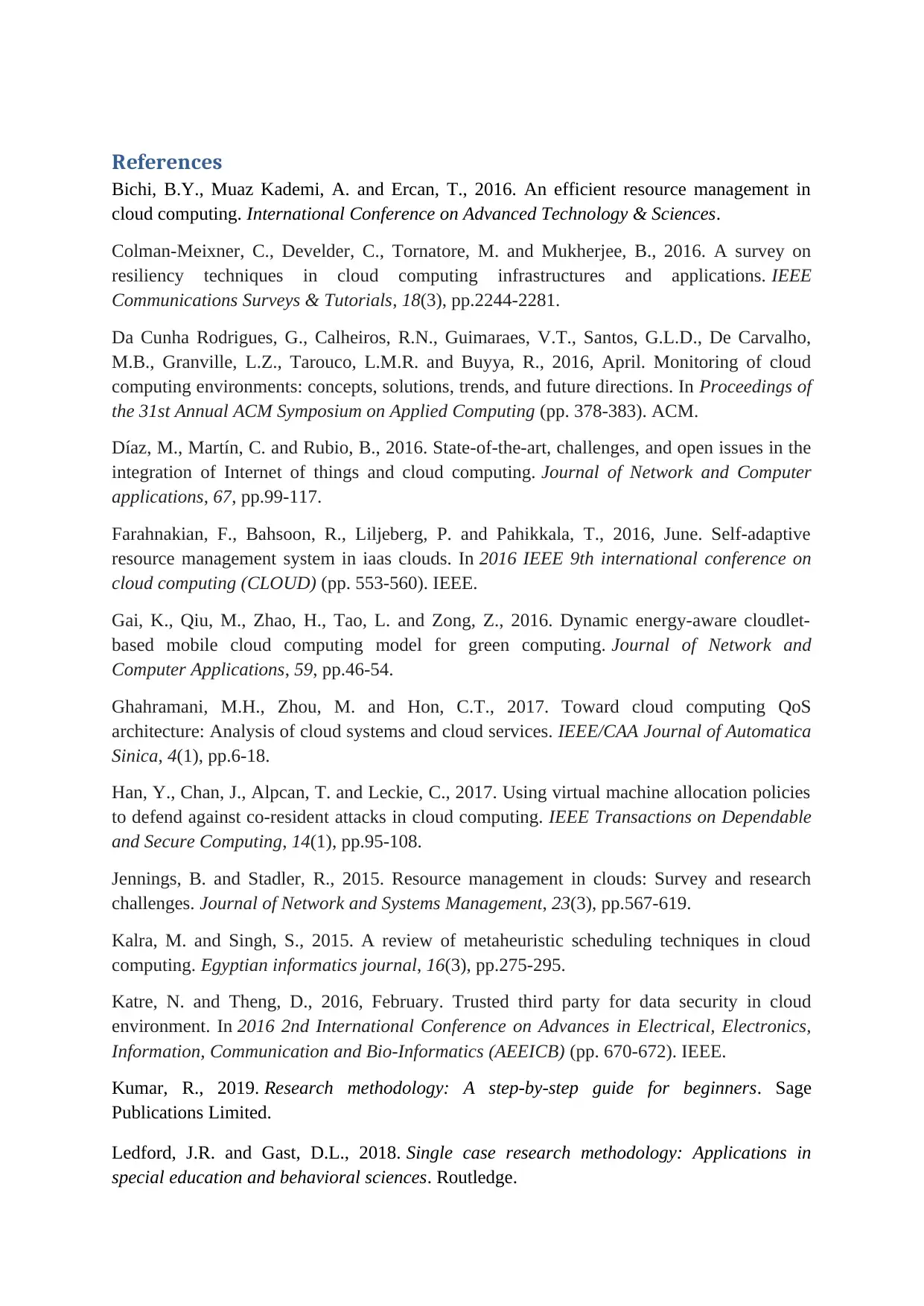
References
Bichi, B.Y., Muaz Kademi, A. and Ercan, T., 2016. An efficient resource management in
cloud computing. International Conference on Advanced Technology & Sciences.
Colman-Meixner, C., Develder, C., Tornatore, M. and Mukherjee, B., 2016. A survey on
resiliency techniques in cloud computing infrastructures and applications. IEEE
Communications Surveys & Tutorials, 18(3), pp.2244-2281.
Da Cunha Rodrigues, G., Calheiros, R.N., Guimaraes, V.T., Santos, G.L.D., De Carvalho,
M.B., Granville, L.Z., Tarouco, L.M.R. and Buyya, R., 2016, April. Monitoring of cloud
computing environments: concepts, solutions, trends, and future directions. In Proceedings of
the 31st Annual ACM Symposium on Applied Computing (pp. 378-383). ACM.
Díaz, M., Martín, C. and Rubio, B., 2016. State-of-the-art, challenges, and open issues in the
integration of Internet of things and cloud computing. Journal of Network and Computer
applications, 67, pp.99-117.
Farahnakian, F., Bahsoon, R., Liljeberg, P. and Pahikkala, T., 2016, June. Self-adaptive
resource management system in iaas clouds. In 2016 IEEE 9th international conference on
cloud computing (CLOUD) (pp. 553-560). IEEE.
Gai, K., Qiu, M., Zhao, H., Tao, L. and Zong, Z., 2016. Dynamic energy-aware cloudlet-
based mobile cloud computing model for green computing. Journal of Network and
Computer Applications, 59, pp.46-54.
Ghahramani, M.H., Zhou, M. and Hon, C.T., 2017. Toward cloud computing QoS
architecture: Analysis of cloud systems and cloud services. IEEE/CAA Journal of Automatica
Sinica, 4(1), pp.6-18.
Han, Y., Chan, J., Alpcan, T. and Leckie, C., 2017. Using virtual machine allocation policies
to defend against co-resident attacks in cloud computing. IEEE Transactions on Dependable
and Secure Computing, 14(1), pp.95-108.
Jennings, B. and Stadler, R., 2015. Resource management in clouds: Survey and research
challenges. Journal of Network and Systems Management, 23(3), pp.567-619.
Kalra, M. and Singh, S., 2015. A review of metaheuristic scheduling techniques in cloud
computing. Egyptian informatics journal, 16(3), pp.275-295.
Katre, N. and Theng, D., 2016, February. Trusted third party for data security in cloud
environment. In 2016 2nd International Conference on Advances in Electrical, Electronics,
Information, Communication and Bio-Informatics (AEEICB) (pp. 670-672). IEEE.
Kumar, R., 2019. Research methodology: A step-by-step guide for beginners. Sage
Publications Limited.
Ledford, J.R. and Gast, D.L., 2018. Single case research methodology: Applications in
special education and behavioral sciences. Routledge.
Bichi, B.Y., Muaz Kademi, A. and Ercan, T., 2016. An efficient resource management in
cloud computing. International Conference on Advanced Technology & Sciences.
Colman-Meixner, C., Develder, C., Tornatore, M. and Mukherjee, B., 2016. A survey on
resiliency techniques in cloud computing infrastructures and applications. IEEE
Communications Surveys & Tutorials, 18(3), pp.2244-2281.
Da Cunha Rodrigues, G., Calheiros, R.N., Guimaraes, V.T., Santos, G.L.D., De Carvalho,
M.B., Granville, L.Z., Tarouco, L.M.R. and Buyya, R., 2016, April. Monitoring of cloud
computing environments: concepts, solutions, trends, and future directions. In Proceedings of
the 31st Annual ACM Symposium on Applied Computing (pp. 378-383). ACM.
Díaz, M., Martín, C. and Rubio, B., 2016. State-of-the-art, challenges, and open issues in the
integration of Internet of things and cloud computing. Journal of Network and Computer
applications, 67, pp.99-117.
Farahnakian, F., Bahsoon, R., Liljeberg, P. and Pahikkala, T., 2016, June. Self-adaptive
resource management system in iaas clouds. In 2016 IEEE 9th international conference on
cloud computing (CLOUD) (pp. 553-560). IEEE.
Gai, K., Qiu, M., Zhao, H., Tao, L. and Zong, Z., 2016. Dynamic energy-aware cloudlet-
based mobile cloud computing model for green computing. Journal of Network and
Computer Applications, 59, pp.46-54.
Ghahramani, M.H., Zhou, M. and Hon, C.T., 2017. Toward cloud computing QoS
architecture: Analysis of cloud systems and cloud services. IEEE/CAA Journal of Automatica
Sinica, 4(1), pp.6-18.
Han, Y., Chan, J., Alpcan, T. and Leckie, C., 2017. Using virtual machine allocation policies
to defend against co-resident attacks in cloud computing. IEEE Transactions on Dependable
and Secure Computing, 14(1), pp.95-108.
Jennings, B. and Stadler, R., 2015. Resource management in clouds: Survey and research
challenges. Journal of Network and Systems Management, 23(3), pp.567-619.
Kalra, M. and Singh, S., 2015. A review of metaheuristic scheduling techniques in cloud
computing. Egyptian informatics journal, 16(3), pp.275-295.
Katre, N. and Theng, D., 2016, February. Trusted third party for data security in cloud
environment. In 2016 2nd International Conference on Advances in Electrical, Electronics,
Information, Communication and Bio-Informatics (AEEICB) (pp. 670-672). IEEE.
Kumar, R., 2019. Research methodology: A step-by-step guide for beginners. Sage
Publications Limited.
Ledford, J.R. and Gast, D.L., 2018. Single case research methodology: Applications in
special education and behavioral sciences. Routledge.
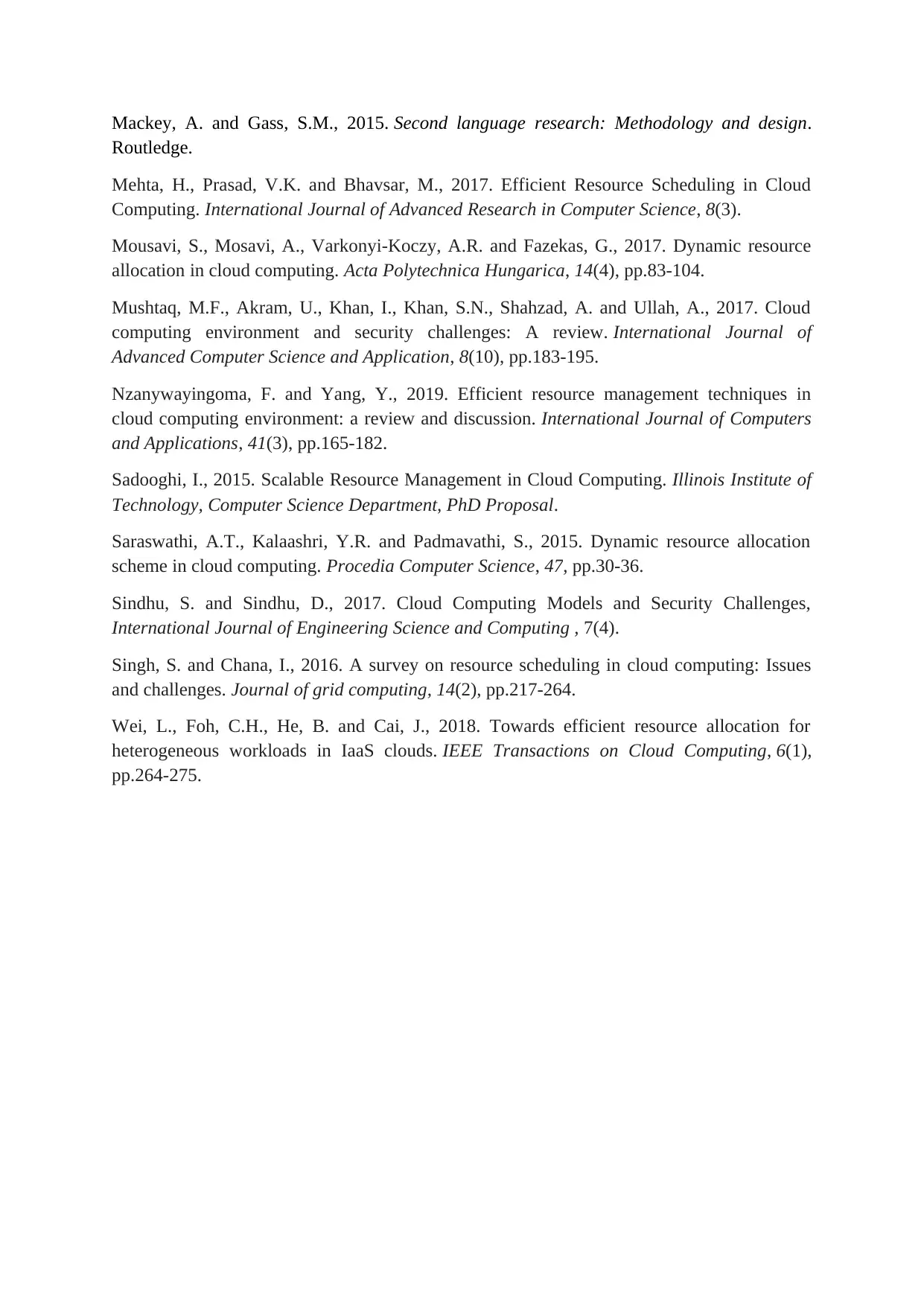
Mackey, A. and Gass, S.M., 2015. Second language research: Methodology and design.
Routledge.
Mehta, H., Prasad, V.K. and Bhavsar, M., 2017. Efficient Resource Scheduling in Cloud
Computing. International Journal of Advanced Research in Computer Science, 8(3).
Mousavi, S., Mosavi, A., Varkonyi-Koczy, A.R. and Fazekas, G., 2017. Dynamic resource
allocation in cloud computing. Acta Polytechnica Hungarica, 14(4), pp.83-104.
Mushtaq, M.F., Akram, U., Khan, I., Khan, S.N., Shahzad, A. and Ullah, A., 2017. Cloud
computing environment and security challenges: A review. International Journal of
Advanced Computer Science and Application, 8(10), pp.183-195.
Nzanywayingoma, F. and Yang, Y., 2019. Efficient resource management techniques in
cloud computing environment: a review and discussion. International Journal of Computers
and Applications, 41(3), pp.165-182.
Sadooghi, I., 2015. Scalable Resource Management in Cloud Computing. Illinois Institute of
Technology, Computer Science Department, PhD Proposal.
Saraswathi, A.T., Kalaashri, Y.R. and Padmavathi, S., 2015. Dynamic resource allocation
scheme in cloud computing. Procedia Computer Science, 47, pp.30-36.
Sindhu, S. and Sindhu, D., 2017. Cloud Computing Models and Security Challenges,
International Journal of Engineering Science and Computing , 7(4).
Singh, S. and Chana, I., 2016. A survey on resource scheduling in cloud computing: Issues
and challenges. Journal of grid computing, 14(2), pp.217-264.
Wei, L., Foh, C.H., He, B. and Cai, J., 2018. Towards efficient resource allocation for
heterogeneous workloads in IaaS clouds. IEEE Transactions on Cloud Computing, 6(1),
pp.264-275.
Routledge.
Mehta, H., Prasad, V.K. and Bhavsar, M., 2017. Efficient Resource Scheduling in Cloud
Computing. International Journal of Advanced Research in Computer Science, 8(3).
Mousavi, S., Mosavi, A., Varkonyi-Koczy, A.R. and Fazekas, G., 2017. Dynamic resource
allocation in cloud computing. Acta Polytechnica Hungarica, 14(4), pp.83-104.
Mushtaq, M.F., Akram, U., Khan, I., Khan, S.N., Shahzad, A. and Ullah, A., 2017. Cloud
computing environment and security challenges: A review. International Journal of
Advanced Computer Science and Application, 8(10), pp.183-195.
Nzanywayingoma, F. and Yang, Y., 2019. Efficient resource management techniques in
cloud computing environment: a review and discussion. International Journal of Computers
and Applications, 41(3), pp.165-182.
Sadooghi, I., 2015. Scalable Resource Management in Cloud Computing. Illinois Institute of
Technology, Computer Science Department, PhD Proposal.
Saraswathi, A.T., Kalaashri, Y.R. and Padmavathi, S., 2015. Dynamic resource allocation
scheme in cloud computing. Procedia Computer Science, 47, pp.30-36.
Sindhu, S. and Sindhu, D., 2017. Cloud Computing Models and Security Challenges,
International Journal of Engineering Science and Computing , 7(4).
Singh, S. and Chana, I., 2016. A survey on resource scheduling in cloud computing: Issues
and challenges. Journal of grid computing, 14(2), pp.217-264.
Wei, L., Foh, C.H., He, B. and Cai, J., 2018. Towards efficient resource allocation for
heterogeneous workloads in IaaS clouds. IEEE Transactions on Cloud Computing, 6(1),
pp.264-275.
1 out of 24
Related Documents
Your All-in-One AI-Powered Toolkit for Academic Success.
+13062052269
info@desklib.com
Available 24*7 on WhatsApp / Email
![[object Object]](/_next/static/media/star-bottom.7253800d.svg)
Unlock your academic potential
© 2024 | Zucol Services PVT LTD | All rights reserved.





